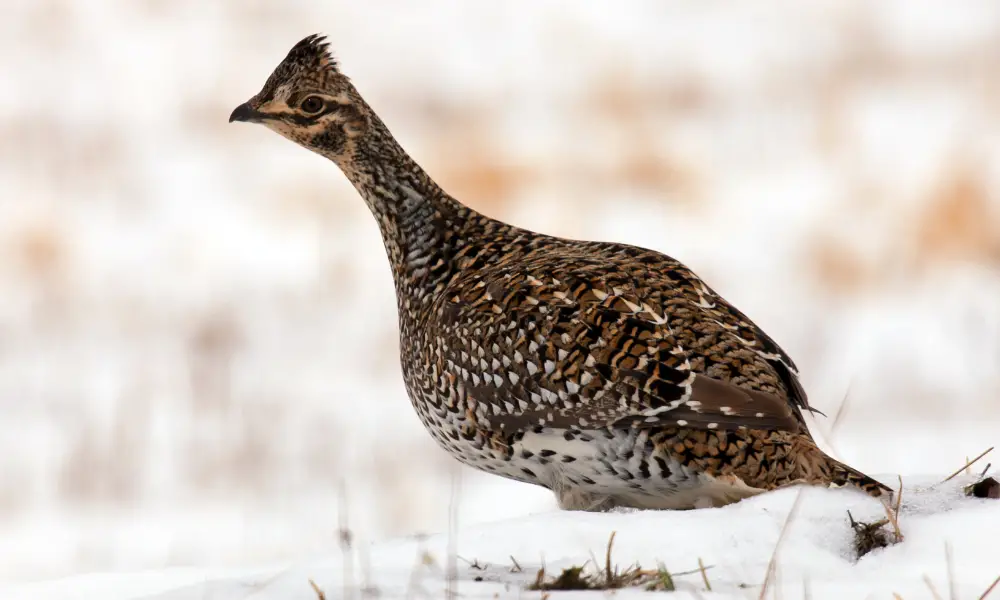
Birds of Pennsylvania
Pennsylvania has a lot of great bird watching opportunities. Pennsylvania has varied habitats so bird watchers of all levels can find something to enjoy. One of the best places to watch birds is at the Pine Grove Furnace State Park, which has a variety of habitats for different types of birds.
Another popular location for bird watchers is Raccoon Creek State Park, which features both water and dry land habitats. Bird watchers can observe migrating waterfowl from October through January.
To see the different types of birds, head to Central and Eastern PA where you’ll find large tracts of forests, small towns surrounded by farmland, and lots of water including the Delaware River system and Lake Erie. Central PA offers the perfect mix of habitat for birdwatchers. In the spring and fall there are lots of birds migrating through the area, while in winter it’s just a nice place to enjoy nature along a snowy drive.
One of the best places for bird watching in Pennsylvania is the Pymatuning State Park. This massive park (more than 6,000 acres) is a mix of forests, fields, ponds, and marshes. Here you can find a wide variety of birds from white tailed deer to bald eagles.
The Susquehanna River Valley has been called “Pennsylvania’s hottest spot for migrating birds and to see birds of prey, venture into the Pocono Mountains for osprey, hawks, and eagles.
The Allegheny National Forest is another great place to see different species of birds, including wild turkeys and bald eagles. But if you want to see fish, too, head out to Lake Erie. At Presque Isle State Park there is plenty of fishing and bird watching opportunities.
Table of Contents
What Are the Most Common Birds in Pennsylvania?
Pennsylvania is a state that has a variety of birds found within its boundaries. It can be hard to keep track of them all, especially if you’re trying to identify a particular bird, and even more so when there are over 400 different species in the state. To make it easier for you we have compiled a list of the most common birds below with a video link to each one of them-
- Scott’s Oriole
- Painted Bunting
- White-faced Ibis
- American Goldfinch
- Tundra Bean-Goose
- Snow Goose
- Western Tanager
- Canada Goose
- American Woodcock
- American Bittern
- Canada Warbler
- Ruff
- Trumpeter Swan
- Brown Booby
- Blue Jay
- Worm-eating Warbler
- Harris’s Sparrow
- Varied Thrush
- Muscovy Duck
- Brown Pelican
- Baltimore Oriole
- Cerulean Warbler
- Rusty Blackbird
- Swainson’s Warbler
- Neotropic Cormorant
What Are the Most Common Backyard Birds in Pennsylvania?
Every state in America has its own unique bird life but if you live in Pennsylvania, the most common backyard birds are many and varied. They include:
- American Goldfinch
- Downy Woodpecker
- Gray Catbird
- Dark-eyed Junco
- White-throated Sparrow
- White-breasted Nuthatch
- House Sparrow
- Blue Jay
- European Starling
- Song Sparrow
- Red-bellied Woodpecker
- American Robin
- Northern Cardinal
- American Crow
- Tufted Titmouse
- Mourning Dove
- House Finch
- Carolina Wren
What Are the Winter Birds that Reside in Pennsylvania?
The birds that make Pennsylvania their winter home range from common and familiar residents to more elusive migrants that only spend a few months at a time here. They are:
Which Bird is the Rarest in Pennsylvania?
Scott’s oriole, a bird with distinctive yellow body and white-striped wings, is a rare occurrence in Pennsylvania that was confirmed by a representative of the Pennsylvania Society for Ornithology.
Northern Yellow-shafted Flicker
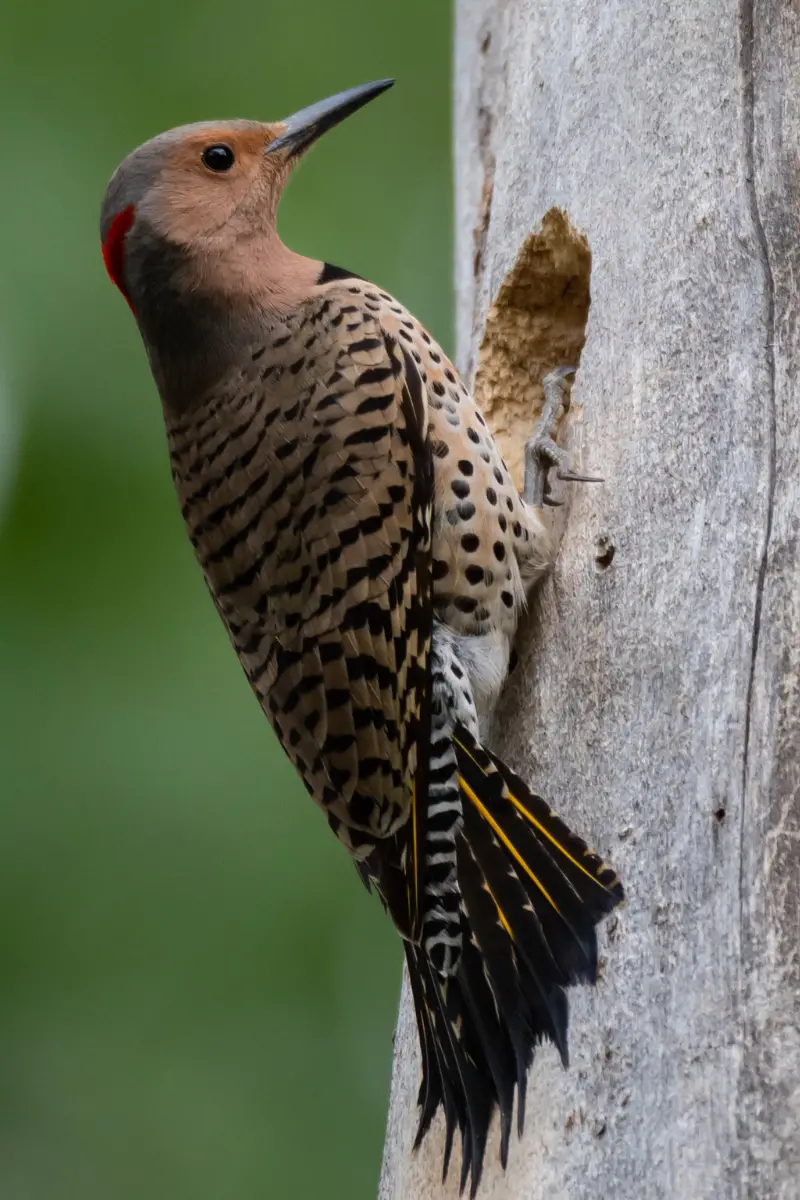
Related to both woodpeckers and sapsuckers, the Northern Flicker could be mistaken for just a large brown woodpecker. This species shows different colorations in the eastern part of the continent (Yellow-shafted Flicker) and the west (Red-shafted Flicker), each distinguished by a flash of color in the wings when it takes to flight; both have a patch of white on the rump.
Nonetheless, since these birds interbreed where their ranges overlap, they are considered the same species (Northern Flicker). Hybrid coloring is common in these areas.
The Yellow-shafted Northern Flicker, known in the Eastern U.S., has completely yellow tail and underwings, with both retricies and primary feathers having yellow shafts. Both sexes are distinctly identified by the red crescent on the nape of the neck, not present on the western (red-shafted) variety.
The head and neck are gray, and the face, chin, and throat are brown, with the male also having a broad black patch starting on each side of the lower beak and down along the side of the throat. In juveniles, the contrast of the brown and black on the face is less distinct.
All varieties of these large birds may have a body length from 10-13 inches and a wingspan from 18-21 inches. The Flicker sports a brown back and wings with black bars. They have a broad black necklace-shaped crescent across the beige upper chest, and the beige belly is heavily spotted with black. The white rump can be seen in flight, and the tail is dark above. The eastern and western varieties differ by the yellow or red wing shafts.
Purple Martins
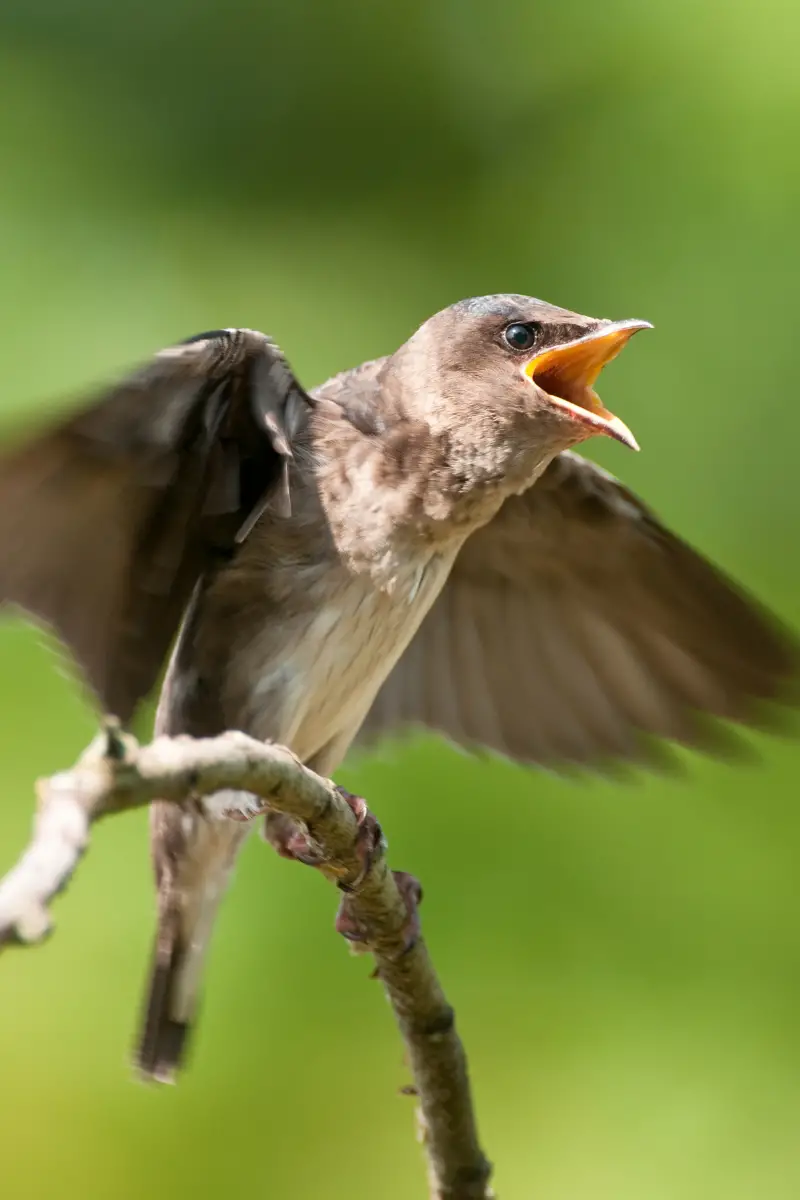
Purple Martins (Progne subis) are well known in eastern North America because they nest in man-made colonies, and in southern North America during fall migration because they roost together in impressive numbers.
Their breeding range extends as far north as the Canadian Maritime Provinces, and into the central Canadian prairies. In most of the western half of the continent, the bird is less common and less conspicuous because there it uses holes in trees and cacti for nesting.
Progne subis adults are about the size of a European Starling and may look similar in flight. Males are uniformly shiny blue-black with a short forked tail and pointed wings. Females look similar but have a light grey breast, neck, and forehead. Western females tend to have lighter breasts.
Colonies are located near water where the birds can find abundant food-like , Purple Martins feed on insects caught in the air. Breeding males arrive first, selecting and defending nesting sites, and waiting for females to arrive a few weeks later.
Green Heron
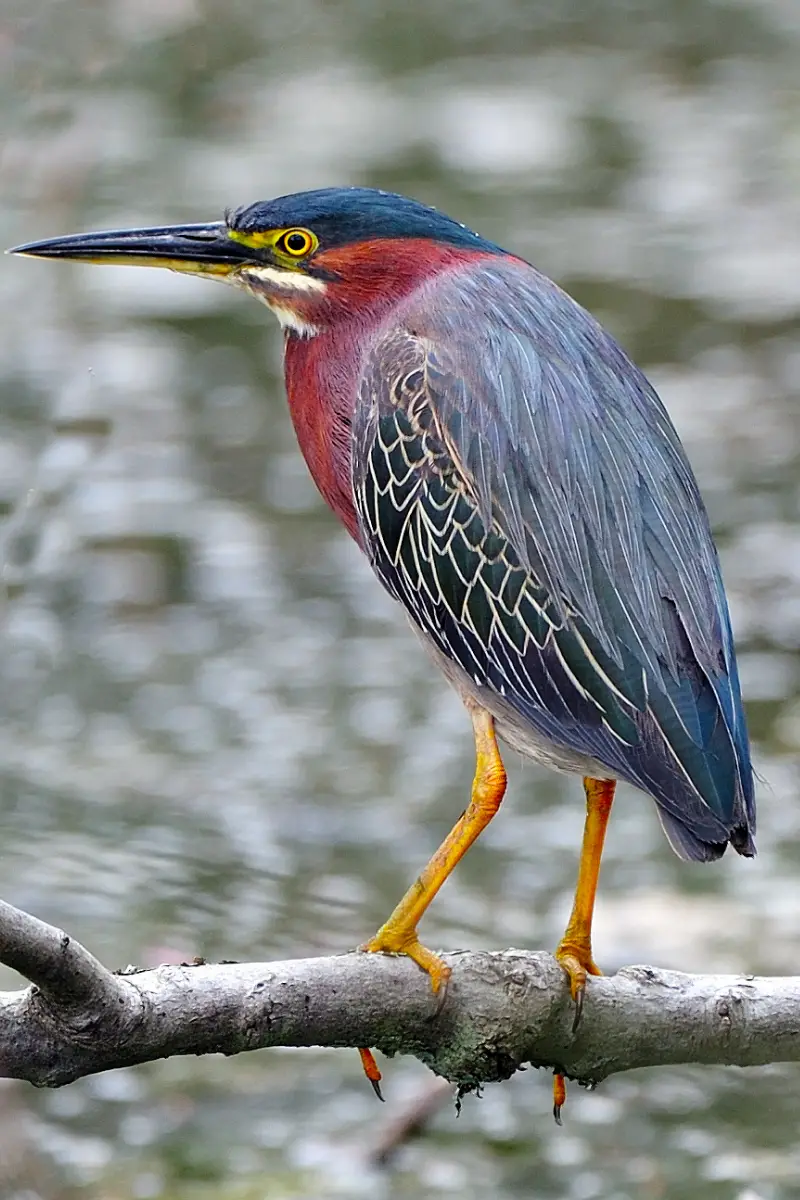
A distinguishing feature of this bird is its green-black crown which is clearly visible against its brown face and neck. The white belly and fore-neck are met with greenish yellow legs and a multi-coloured bill of brown and green. The bill is the most valued tool of all herons as it allows them to spear their food with one quick movement of their neck.
The Green Heron is most commonly seen in the southern parts of Ontario and is fairly sparse in the central and northern regions. They are most commonly found along freshwater streams, marshes, and lakes.Their short legs allow them to stay close to the water and to more easily claim prey. A Green Heron prefers a dense shoreline of emergent vegetation which allows them to hide easier when feeding. Being a very cautious bird, the Green Heron is most commonly seen flying quickly from a bush or shrubs with a sharp call.
These herons feed off small aquatic animals, such as: small fish, frogs, tadpoles, crayfish, as well as small rodents and snakes. Like most herons, the Green Heron waits and stalks its prey before quickly striking with its long sharp bill.
Least Sandpiper
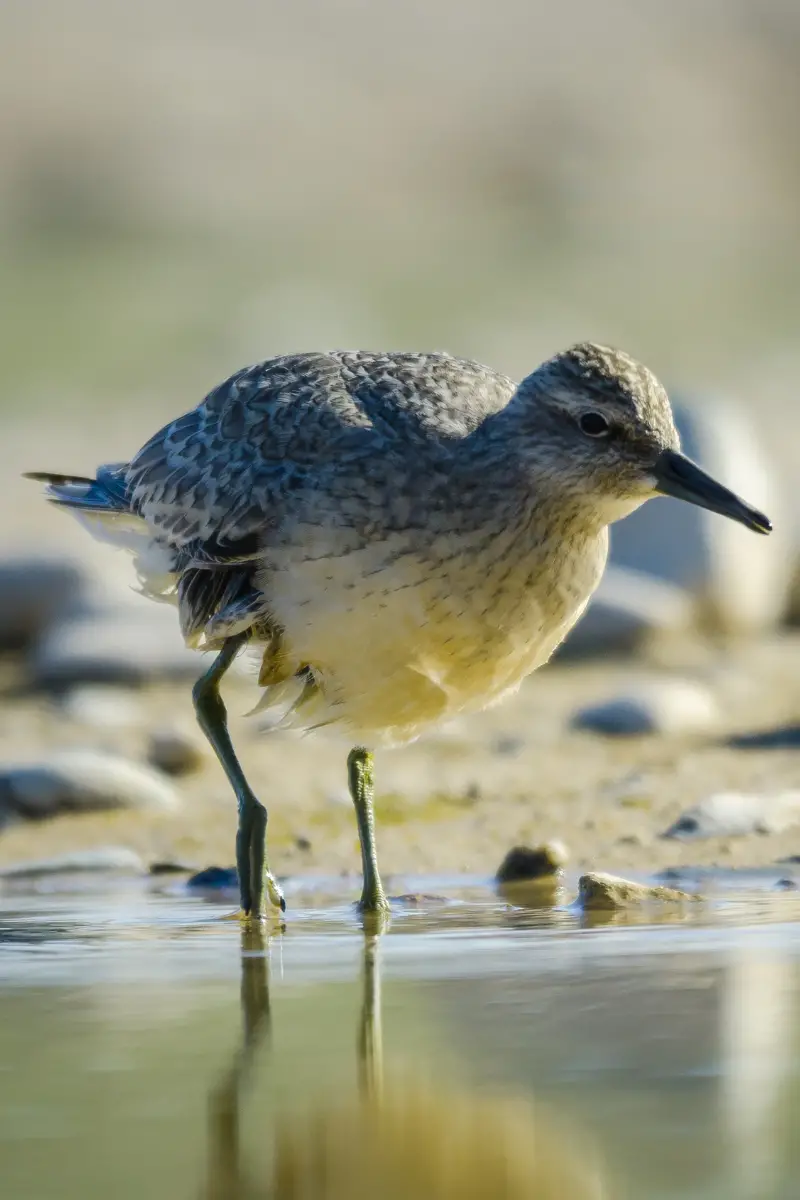
The Least Sandpiper has a brown colored chest slightly spotted with black and a white stomach. They have a pale stripe over its eye. It has a small, slender, delicate and curved beak with yellow legs. The black stripe on its rump continues onto its tail. Both sexes are similar in color.
Adult alternate: The head of the Least Sandpiper is brown with a dark colored plumage and brown edges on its wing feathers. Its chest is brown with black spotted marks. The bird’s stomach is ivory with a dusky colored crown.
The an average wing length is about 3 1/2 inches and the average tail length is about 1 1/2 inches long.
The Least Sandpipers breed in bogs and marshes with open areas and they build their nests in a hollow or a mere depression on the dry ground near water in the tundra in Central Alaska and across Northern Canada. They also breed in Nova Scotia, Magdalen Islands, the Gulf of St. Lawrence and the Sable Islands. They line the nest with grasses and moss.
After mating the female Least Sandpiper lays four eggs, colored yellow, brown with chestnut and lavender colored spots. Usually the male bird sits on the eggs alone for about 21 days and then the new birds hatch and they have one brood each year.
The birds search for food on mud flats Their diet consists mainly of aquatic invertebrates like small crustaceans, mollusks, marine worms, snails and insects like mosquitoes, beach fleas and flies. Sometimes they find food by sight and sometimes by exploring the bottom of the mud flats with their bill. They will eat some plant matter.
Oystercatchers

Some Oystercatchers are completely black while others are pied. Pied Oystercatchers have a black head, black top parts, a white belly and rump, white tips on its primary wing feathers and patches on secondary feathers. They vary in length from 16 inches to 21 inches. Their feet have three toes colored pink to pale pink depending on age. The bill of the Oystercatcher is about 3 1/2 inches long colored bright orange during breeding season and duller the rest of the year.
The iris of their eye is bright scarlet and the female bird is slightly larger than the male. While sleeping the Oystercatcher hides its beak under its feathers. These birds will mob a predator vigorously driving the predator away before it finds the Oystercatchers eggs.
The birds can only feed at low tide and do feed during the day and in the evening. Because they choose to live, feed, breed and raise their young on beaches and sand dunes humans invade their territory, often without knowing.
Also pairs of Oystercatchers differ in their feeding and breeding habits that helps species separation and allows peaceful coexistence.
The bird with its long beak pull mussels off their beds, turn them over and hammer a hole in the flat surface and cut the strong abductor muscle that holds the two halves of the shell together. Once this muscle is severed the bird can use its bill as a lever prying the shells apart. The Oystercatcher then chisels out the meat with scissor like movements of the bill. The ventral surface is the weakest area of the mussel shell and the Oystercatchers adapted to opening the mussel in the easiest possible manner. When the mussel is underwater the shell halves gape so that the bird can sever the abductor muscle with one quick stabbing action, without breaking the shell.
Some Oystercatchers specialize in eating limpets. Undisturbed limpets relax and do not grip rocks tightly. The birds target the limpets by stalking and sneaking up on the prey quietly, quickly sliding its beak beneath them and knocking the limpet from the rock quickly before the limpet can grasp the rock tightly again. This can be dangerous for the Oystercatcher. If the limpet grasps the rock tightly when the Oystercatcher slips it long beak beneath the limpet and the bird cannot knock the limpet off the rock and the bird cannot retrieve its bill the bird will drown at high tide. While living inland they eat worms and insects.
Some Oystercatchers may live for 35 years, yet, they do not breed until they are three years old. Normally the Oystercatchers breed among the sand dunes on beaches and rocky shores. Inland breeding is uncommon but does occur in Northern Britain, The Netherlands, and around the The Aral Sea in Russia. Some birds nest as high as 2,000 feet in Scotland. In low lying parts of Scotland the female lays her eggs in mid April in newly sown fields. When breeding inland their territories are in fertile fields. Pairs that remain together usually nest in same region year after years and some birders suggest the pairs stay together during the winter too.
The Cardinal
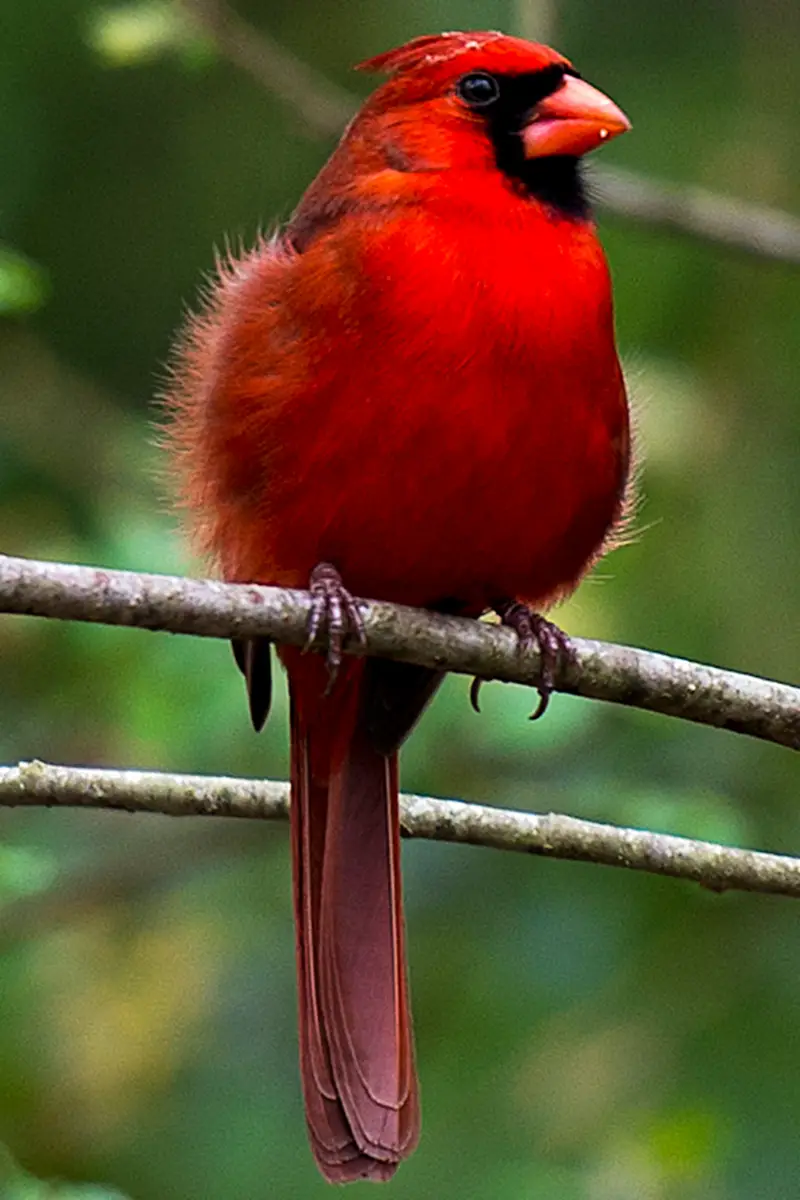
Long ago prized as caged songbirds, Northern Red Cardinals are non-migratory, although their range has expanded over the last 100 years. It was a native bird only in the southern U.S. until the slowly increasing temperatures in New England and the Great Lakes regions starting in the late 1950s encouraged their moves into these areas.
The Red Cardinal is a medium to large bird about 8-9 inches long, weighing about 1¾ ounces, with a wing span of 10-12 inches. The male’s body coloring ranges from a dull red hue to a brilliant dark red, with a distinct black face and bib surrounding a conical red bill.
All cardinals have dark pink legs and feet. The paler males are thought to possibly have poorer diets. The males with the deepest red colors to feed at higher rates, claim the most densely vegetated territories, and have greater reproductive success than their duller-colored counterparts.
Juvenile Northern Cardinals have smaller crests than adults and are a dark mousy brown with light underbodies and cinnamon tails. Sometimes mistaken for Cedar Waxwings whose range overlaps, the juveniles have no black on their faces like waxwings; the young males get black faces only when maturing enough to turn red. The female cardinal is also a drab brown with a more variegated shading on her back than the juvenile and a buff-colored underbody.
Bicknell’s Thrush
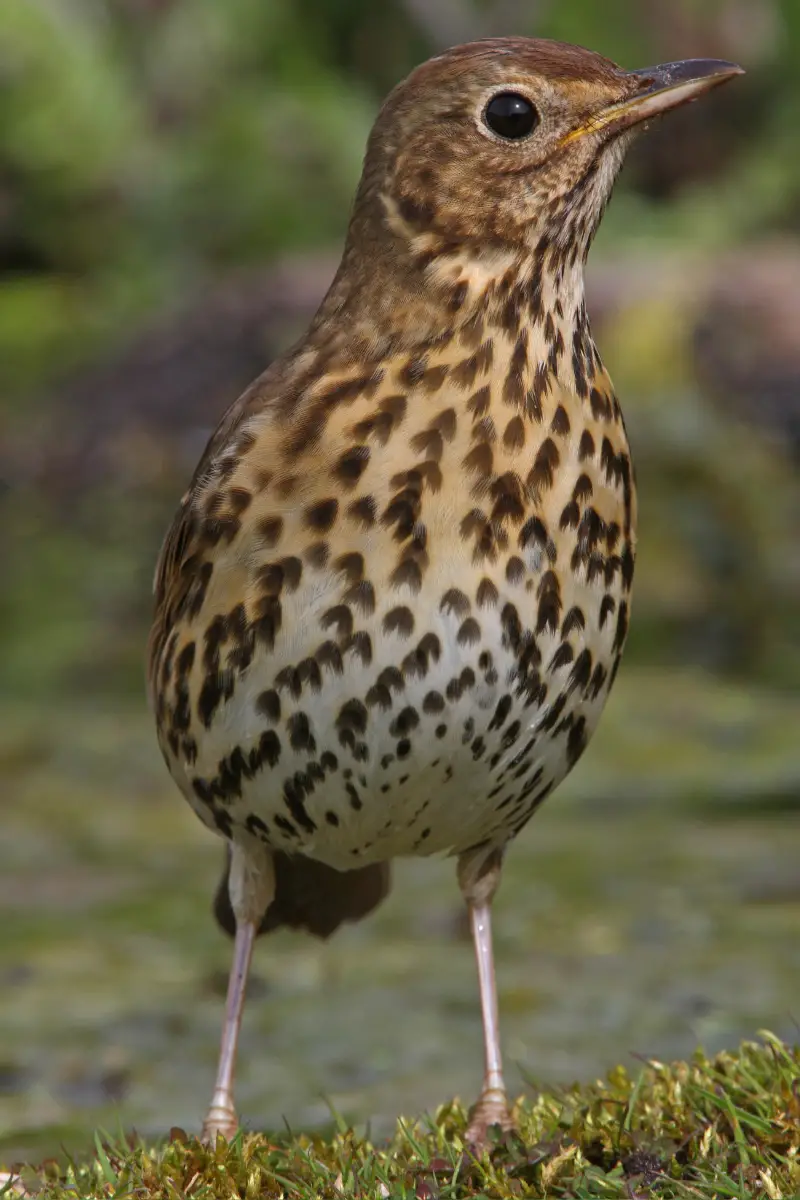
Bicknell’s Thrush is found only in northeastern North America – both Canada and the United States have populations in isolated patches from southeastern Quebec and northern Nova Scotia, south to the Catskills of New York. The birds migrate south to the Dominican Republic, Haiti, Jamaica, Puerto Rico, and Cuba for the winter.
During the breeding season, Bicknell’s Thrush prefers disturbed or stunted forest, particularly montane forests (wet forest at high elevations): the dense stunted forests found in exposed chilly areas of Eastern Canada, areas regenerating after storm or fire damage, and natural or planted regrowth in forestry clearcuts. The patchy distribution of this type of habitat explains the similarly patchy distribution of Bicknell’s Thrush. In its winter range, Bicknell’s Thrush also frequents high montane forests.
Nesting begins in June with three or four chicks being reared in nests constructed of twigs and moss. Females mate with more than one male, producing broods with mixed paternity, and chicks are fed by both male and female birds with some nests receiving contributions from several males. During the breeding season, Bicknell’s Thrush eats primarily insects and other arthropods; fruit is added to the diet in the winter months.
Eastern Meadowlark
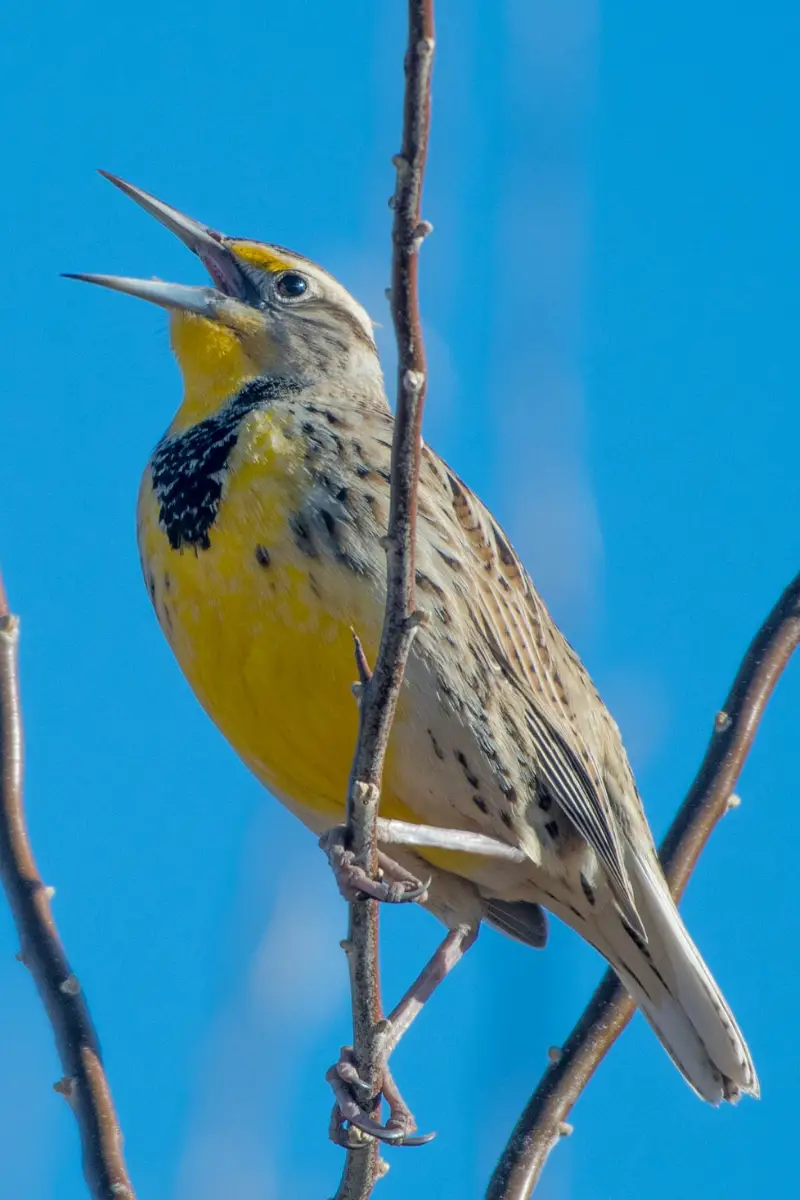
Meadowlarks are often depicted or photographed sitting on a fence post. This is no coincidence-the male meadowlark characteristically sits on roadside fence posts in the spring and sings to claim his territory. This, and the fact that these birds have a bright yellow breast, makes them highly visible and familiar to passersby.
If you see a bird, therefore, with a striking yellow breast marked with a prominent black V, sitting on a US fence post and singing for hours, it is a male meadowlark. He’s singing to announce that he has claimed the territory (an average of about seven acres) for breeding-he may eventually have up to three females with nests in the area if he successfully defends it from other males. While females are nesting the singing stops, but it will resume again if the birds nest a second time.
The meadowlark’s song is a key feature for determining whether the bird you see is a Western Meadowlark or an Eastern Meadowlark in places where their ranges overlap. The song of the eastern bird is a simple melody of just a few notes, while the song of the western species is complex and often described as gurgling or bubbling.
Meadowlarks are able to force things open with their beaks, an action called gaping. This helps them probe for food under the soil surface.They eat mostly spiders, insects, and other invertebrates in the summer, switching to a diet of mostly seeds in winter.
The female meadowlark builds a nest in a natural depression in the ground. She modifies the depression with her beak, lines it with grass, and then weaves a waterproof dome over the top with adjacent grasses and plant material collected from nearby. The result is a nest that looks exactly like a hump of grass. often trouble meadowlarks, leaving their eggs in the meadowlark nest and forcing meadowlark adults to raise cowbird young.
Meadowlarks often choose unfortunate nesting sites: a nest in a field of alfalfa, for example, is likely to be mowed before the young have fledged. If a meadowlark feels threatened by a predator, it crouches down to hide its bright yellow breast. Its back is colored in streaked brown helping the bird blend in with its surroundings.
Red Winged Blackbird
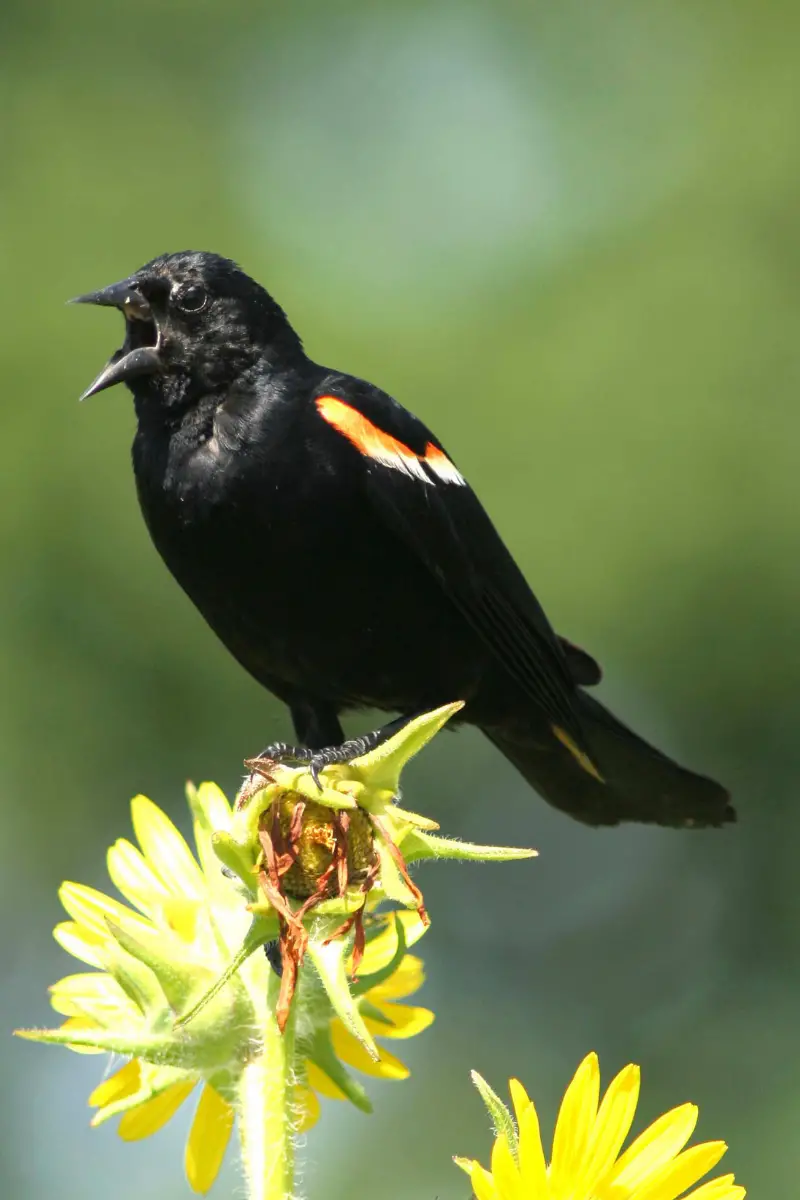
Red Winged Black Bird (or Redwing, Marsh Blackbird and Swamp Blackbird) habitat includes Alaska east across Canada to Newfoundland. On the West coast of North American birders see the Red Winged Blackbird from Alaska to Baja California and Central Mexico and on the East coast from Newfoundland to Florida.
In the snow covered months you will find the Red Wing Blackbird regularly across The United States north to British Columbia, The Great Lakes states and provinces and Pennsylvania.
The bird’s principal color is black. The adult male Red Winged Black Bird has a bright red patch on its wings edged by yellow and a sharply pointed bill. They can hide these spots when they do not want to draw attention to themselves. At maturity it stands from seven to 9 1/2 long but smaller than a robin.
Female and young redwings have stripe of dusky brown.The immature male Red Winged Blackbird has similar coloring to the adult male bird but has pale colored eye brows and brown borders to its black plumage.
The adult female Red Winged Black Bird has pale colored eye brows and stripes on their belly and breast. Their back has brown and white striping and occasionally has traces of yellow on its face and throat.
Female Red Winged Blackbirds have drab brown coloration’s and often mistaken for sparrows. The young Red Winged Blackbird is similar in color to the adult females.
The female lays between three to five blue eggs, speckled and with dark brown and purple coloring. She sits on the eggs for about eleven days. After hatching the young birds fledge in about fourteen days. Depending on the length of the growing season the Red Wing Black Birds have two and sometimes three broods a year.
Redwings eat a variety of food. Their diet consists primarily of seeds with a with some insects to supplement their diet. During the nesting season, they eat mainly insect. Hayfields and clover fields benefit from the Red Winged Blackbird’ s nesting sites. Insects make up their diet in warm weather In the winter time they eat grains, seeds, and other foods. During a severe infestation of periodical cicadas, Red Winged Blackbirds take cicadas while in flight.
The Chimney Swift
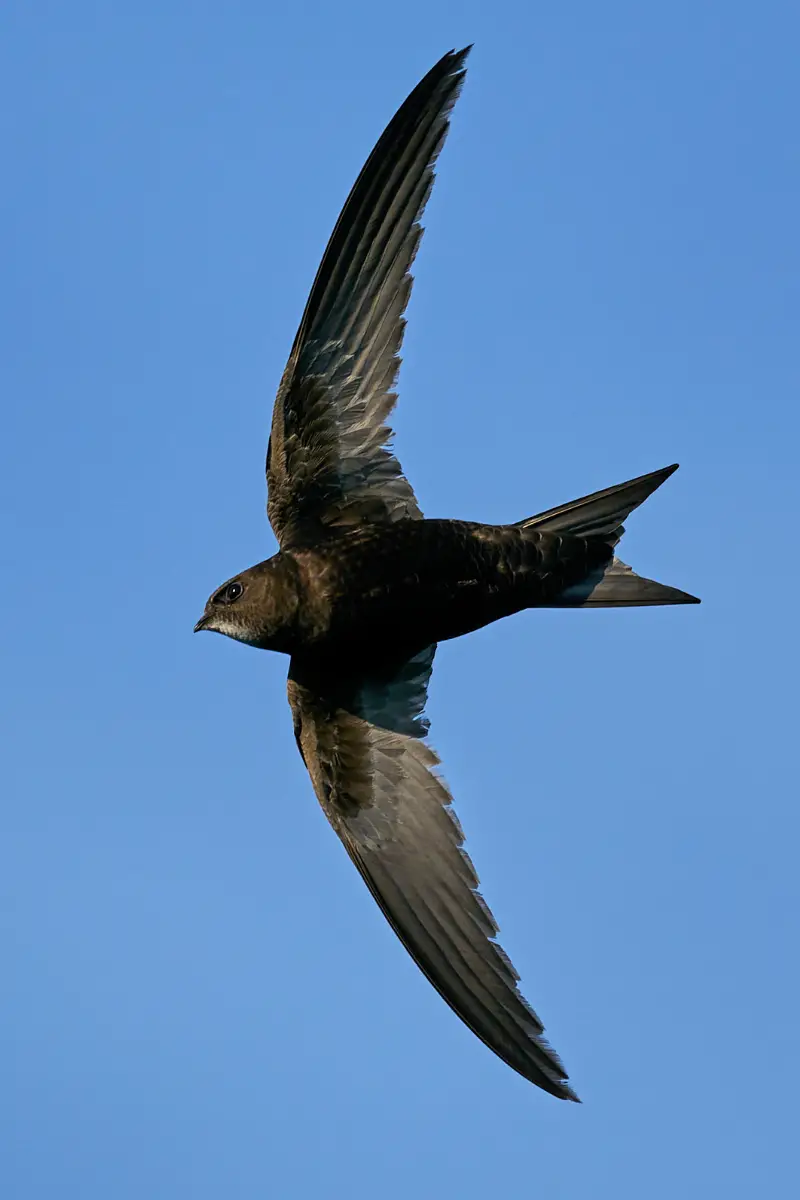
Swifts closely resemble swallows in both appearance and behavior, but they are really not related at all. They do spend the majority of their time in the air feeding on small insects however they tend to fly much higher than swallows or martins.
Chimney Swifts spend their winters in central or South America. When summer arrives, they choose the eastern United States including Pennsylvania and the lower part of eastern Canada.
Being well suited for flight, the Chimney Swift has long wings that allow for rapid, stiff, wing-beats. This speed allows them to fly in a more direct pattern as compared to the traversing flight of other birds. Their short, stubby tails have a squared look to them with small projecting quills. They are dark in color, and unless seen by a savvy birder, would not be easily identified by the inexperienced eye.
The Chimney Swift is about 5″” in length (12.5 cm). The birds build a hammock-like nest of twigs and grasses held together by saliva against the inside walls of chimneys, or other such buildings. It is just after dusk when the swifts flock above their chimney dwellings in circular flight patterns, preparing to roost.
When male and female swifts breed, they perform courting rituals that involve sustained flight and the triumph of the fittest. The actual mating takes place in the air during flight. Females lay a clutch of 3-5 round, white eggs. Incubation is 19 days.
Once hatched, they begin life at about the size of a thumbnail! Parent birds feed the young swifts by regurgitating food directly into their mouths. The young birds venture out at about 2 ? weeks of age. They exercise while in the confines of their chimney or crevice dwelling by beating their wings rapidly over and over, enabling them to gain strength and stamina.
After about 26 days, fledgling swifts begin small flight maneuvers up and down the length of the chimney. By the age of 6 weeks, they are strong and ready to begin a life of aerial survival.
Pileated Woodpecker
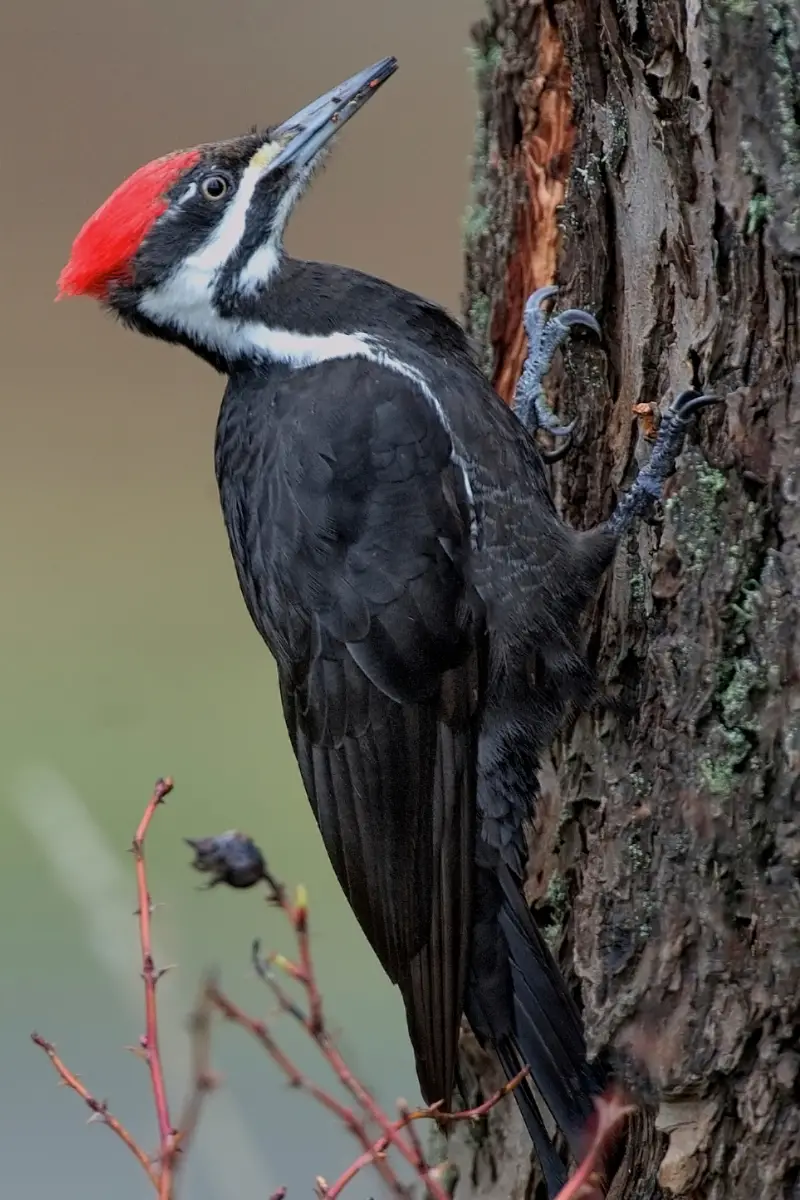
You will probably hear a pileated woodpecker before you see it. The loud hammering on trees is an indication a woodpecker is around, looking for bugs to eat. Or it might be mating season, where it is calling for a partner. It is a shy bird that is hard to spot, but when you do, it is a treat!
While one of the largest woodpeckers in North America it is still so shy that not many will come in to backyard birdfeeders. They spend the majority of their life clinging to the side of a tree, looking for food. Their diet staple is carpenter ants, which they prefer over all kinds of bugs. Sometimes they hop on the ground or around fallen logs searching for bugs.
The pileated woodpecker stands between sixteen and nineteen inches tall. It is black, with a red crest and white stripes on the neck and face. The only difference between males and females is the color of the forehead and the lack of mustache on the female. The males have a red forehead and moustache, whereas the females are a dull brown or gray color. They both have a sharp, strong beak used to carve holes in trees. A juvenile of either sex is duller in color.
The female will lay between three and five eggs once every year. The female incubates during the day and the male takes a turn during the night hours. The eggs are plain white and hatch in 15 to 18 days. Babies will fly off within 26 to 28 days and find their own territory. A pileated woodpecker can live as long as ten years.
Pileated woodpeckers live in large, mature forests in Pennsylvania and Eastern United States, southern Canada and the Pacific Northwest of the US. It needs the old trees since it makes many small holes to pull out insects with its long, sticky tongue.
American Woodcock
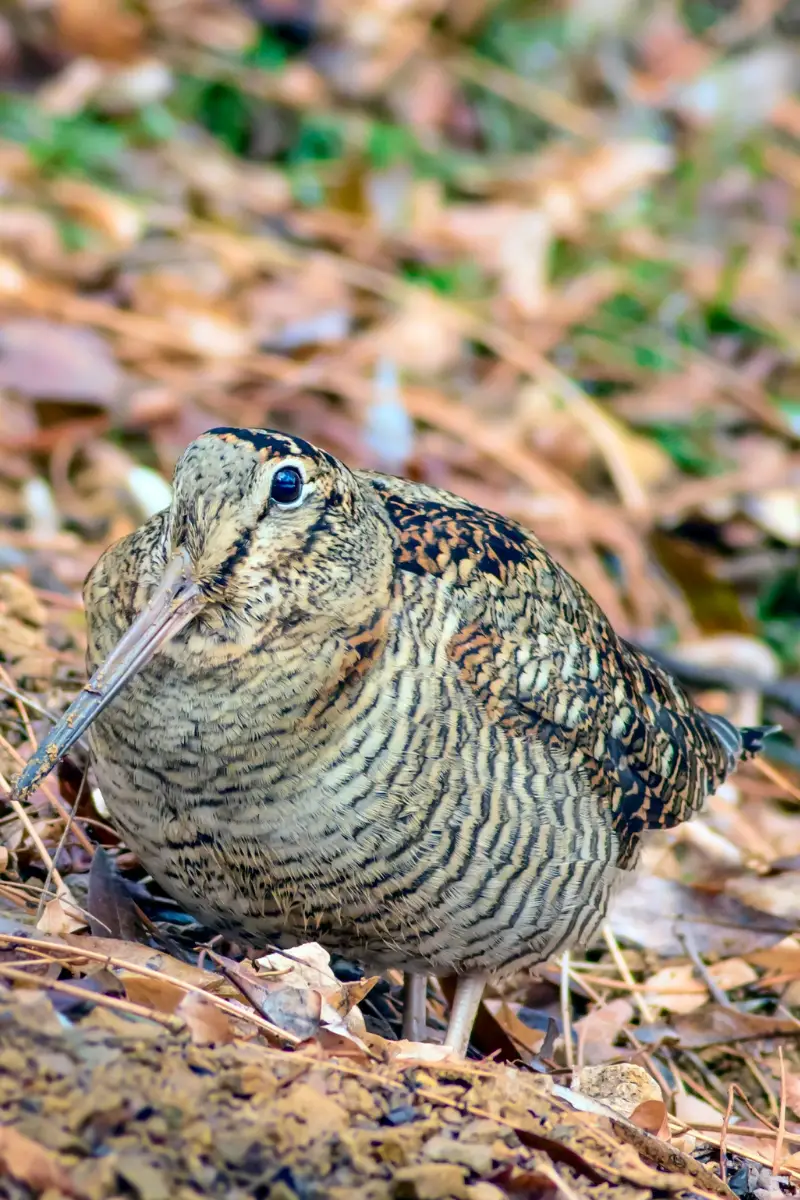
This upland bird with a black nape, crossed by pale lines, dark eye line and a stripe by its ears gradually work their way south as the ground freezes along its migration route. The woodcock, a bird of the alder trees displays a gray-brown back, with reddish-brown upper wings, rusty rump and laced with rusty wing linings.
The Woodcock, stands about 8 1/4 tall, difficult to find because of their blending coloration, small size, and preference for areas with dense vegetation. This dumpy, short-tailed shorebird that wobble like tiny Gooney Bird noisily takes off when flushed and their wings make twittering sound in flight.
The Woodcock is a very common resident from March to October in Pennsylvania and the northern half of the USA and it is difficult to tell the difference between the sexes or large immature birds because they all are marked similarly.
Woodcock eat mainly earthworms and some birds will eat some seeds. Earthworms are their number one meal and Woodcock are not likely to adapt to other meals even if forced by nature. Woodcocks will seek out other climates or starve rather that change diet.
This upland bird has a very long bill and very large, dark eye set high in head. Birders find woodcock in marshy, low-lying areas, along water courses, woodlands and shrubby fields where the ground is rich in nutrients and full of earthworms. Thus, you find Woodcock in a variety of places, including residential areas.
Habitat management for woodcock can be similar to that for grouse but the ground used is often lower and can be next to a marsh in the long grass. You will find Woodcock populations in all wooded areas but, best in young aspen stands and alder creek bottoms.
European Starling
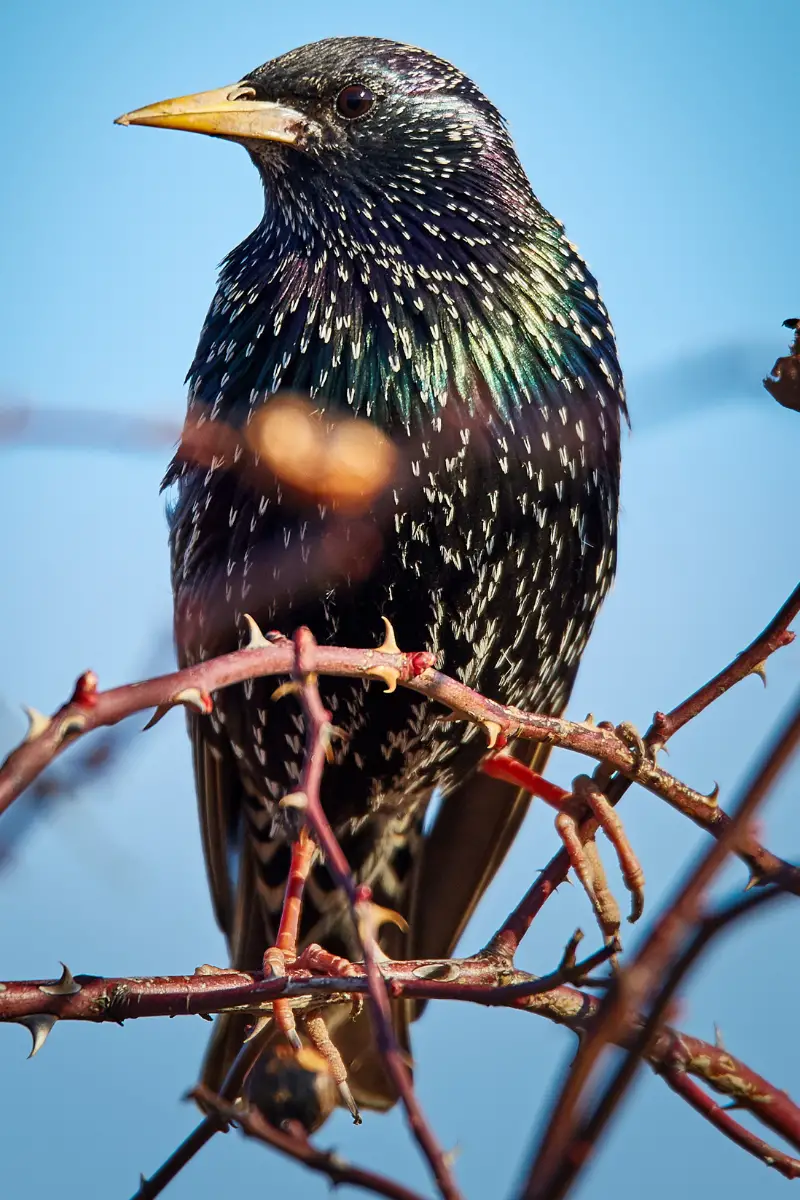
European Starling ranges throughout North America except in the cold northern reaches. Its population exceeds that of the species in Europe, and the damage it inflicts on farming operations is considerable.
Sturnus vulgaris has proved to be an adaptable bird that does well wherever people provide it with and food:
Although starlings don’t migrate along established routes, many do move south in winter to find warmer regions where food is more readily available. This seasonal movement has carried them into new territory that is also acceptable for year-round residence and breeding, thus expanding the range.
The species is prolific. Though pairs typically raise only one brood in colder regions, two or even three broods are possible where the climate permits. A high proportion of young survive where their insect food is readily available, quickly increasing the population.
Waterways into the interior of the continent likely provided corridors for quick dispersal of starlings in the early years, though they ultimately dispersed throughout the continent favoring areas near human communities.
Even in North America, where the European Starling is an exotic species, attitudes toward the birds range from bitter enmity to tolerance and even admiration. Control measures regularly involve poisoning the birds and attempting to keep them away from crops and grain stores.
Caspian Tern
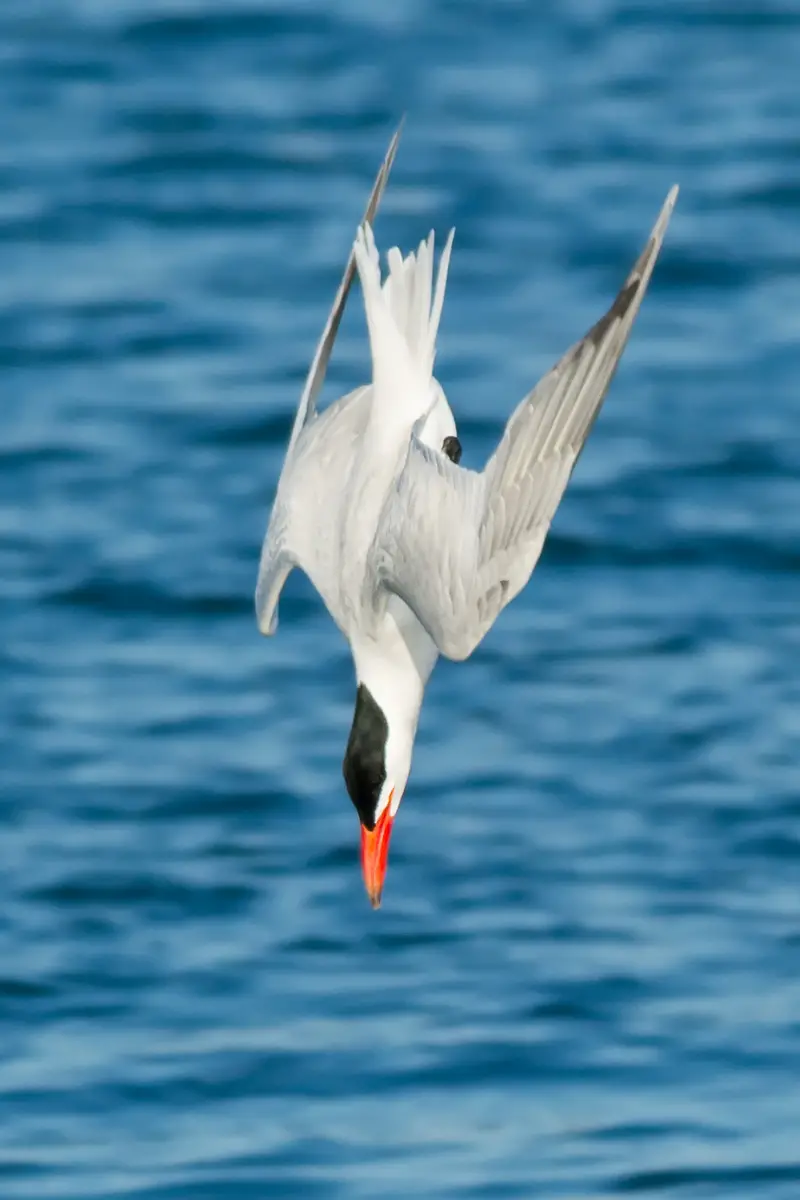
Although the Caspian Tern, about 22 inches tall with a forked tail has nearly world wide distribution, its only known breeding area includes only one site in Quebec.
This almost wholly white sea bird with a layer of grayish blue plumage displays a crown of greenish/ black. Its bill is vermilion in color with its feet colored black or brown has a white spot on the lower eyelids.
The Caspian Sea Tern does not build a nest like other birds. Their nest is a hollow scooped in the sand. It usually nests in colonies with other Caspian Terns, but may join the Common Tern or Ring-billed Gull colonies and nest with them. Sometimes they nest in isolated pairs.
After mating the female lays clutches from one to four eggs and incubation takes about 25 days. The young Caspian Terns fledge at 33 days.
Though seen also in Pennsylvania, its main territory is in and around the Great Lakes. Its main diet consists of alewives and Rainbow Smelt, but occasionally will take Yellow Perch and Rock Bass.
Barred Owl
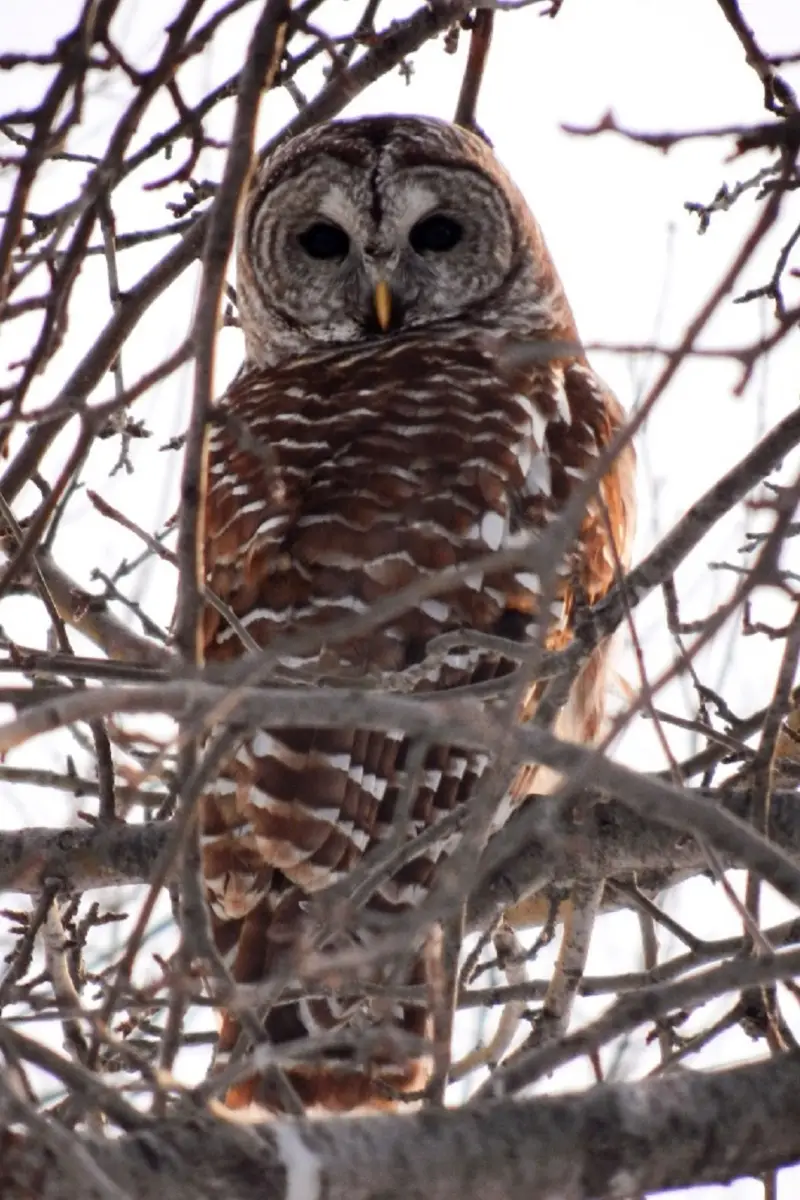
An ordinary raptor in the Pennsylvanian woods, the Barred Owl is more expressive in voice and not as big as its relative, the Great Horned Owl.
This bird of prey that is about two feet long at adulthood is gray-brown on top with glistening white spots. On its underneath, it has gray and white “”barring”” that takes place where the craw and bosom converge.
This balanced barring makes the Barred Owl appear as if it is wearing a white neck band. Its breast has upright stripes and some barring. The head of this owl is circular and doesn’t have tufts. Encircling its big moistened brown eyes are light brown feathers and the owl has a wingspan of about 43 inches. Its bill is a dull yellow.
Altogether people think of the Barred Owl as sweet and timid particularly when comparing it to the ferocious looking Great Horned Owl. This owl is the only owl in the eastern United States with brown eyes.
However, the Barred Owl may appear timid, but it is a proficient predator. The Barred Owl is a unusually vocal owl. Indeed it is so boisterous and noisy that it can be quite easy to detect. Its regular call is a tolling intonation of successive hoots.
Some people conclude that the hooting of this owl sounds like someone casually saying, “who-cooks-for-you, who-cooks-for-you.” This raptor makes many other calls that range from a brief hoot or woof to an aroused and boisterous monkey-like squawk that can make the locks on one’s neck stand on end.
The female lays two to three white tinted eggs and incubates them for about 28 days. These eggs are laid either in a tree hollow or in the unclaimed nest of another big bird. The young fledge about 42 days after hatching.
One of the most common nests that this raptor uses is that of the Red-Shouldered Hawk. It uses this hawk’s nest because it is huge and because they both share the same surroundings. Nesting preference is the cavity of a tree or the abandoned nest of a hawk, crow or squirrels.
The Barred Owl chooses deep humid timberland, wooded marshes, and woodlands near waterways. Birders spotted this raptor in the eastern half of the United States stretching out west through southern Canada.
Other outdoor people detected the Barred Owl out west in the states of Washington and Oregon. In these states it contends for territory with its close relative the Spotted Owl.
The Barred Owl is generally a night hunter. Its prey are little mammals, reptiles, amphibians, crayfish, and some small birds. In fact, this raptor has commonly attacked and ate other smaller owls! Also they will include its smaller cousin, the screech owl, in its diet. A very opportunistic hunter, the Barred Owl occasionally is seen hunting before dark. This particularly happens during the nesting period or on dim and overcast days.
Common Grackle
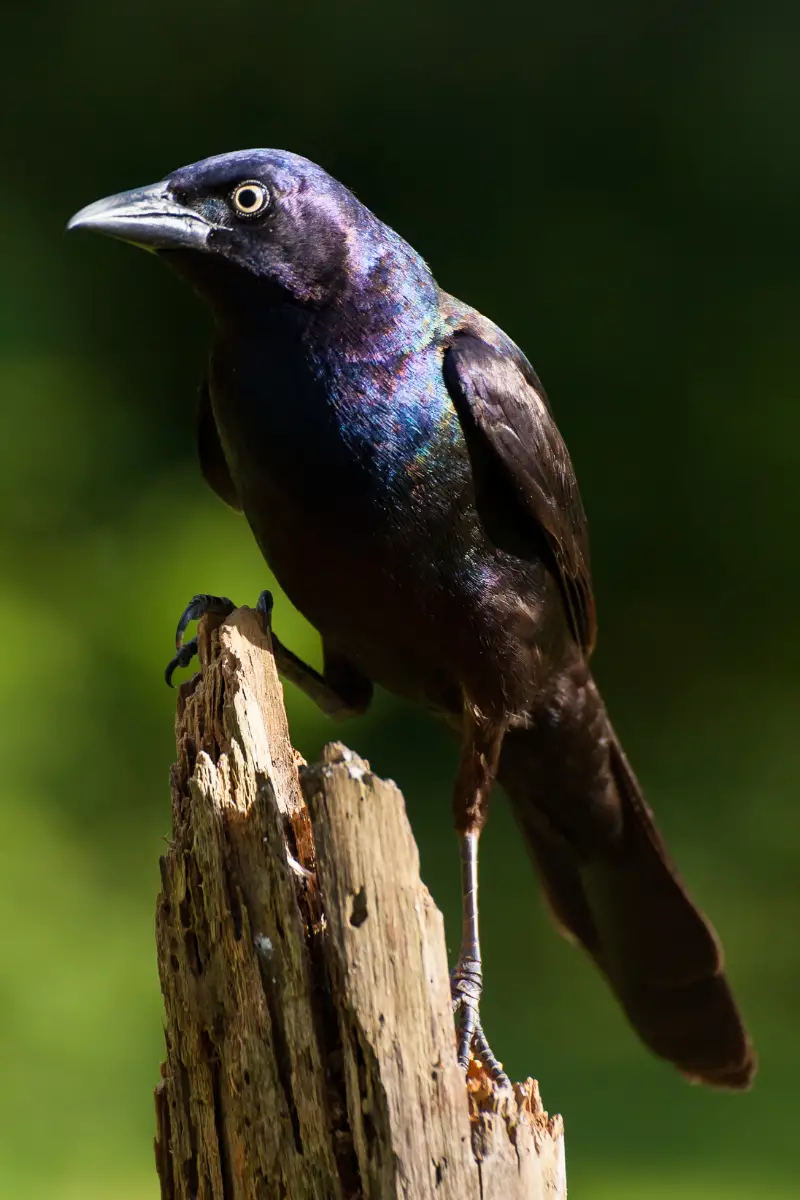
A mixture of plant and animal foods make up the diet of the Common Grackle. The birds prefer to feed on the ground, and eat invertebrates such as insects, insect larvae and worms that they find in the soil. They’ll also eat small vertebrates including fish and baby birds, as well as seeds, nuts, and even human garbage. Common Grackles often visit feeders, where they monopolize bird feed and prevent other birds from eating it. They have long been accused of damaging corn crops, though they may actually be more interested in eating insect pests of corn such as cut worms and corn borers, than they are in the corn itself.
Though it’s not unusual to see a solitary grackle, Common Grackles tend to feed, rest, roost, and even breed in groups. Typically nests are built high up in evergreen trees:
The nest is constructed of various materials including grass, twigs, leaves, and even pieces of garbage. It is reinforced with mud and lined with softer grass or hair and fur.The female lays between one and seven eggs, which hatch after about two weeks.Fledglings are ready to leave the nest after about another two weeks.Young Common Grackles are plain brown birds with dark eyes.
According to the (IUCN), there are almost 100 million Common Grackles in North America. National Audubon estimates are lower at just over 70 million, and survey data indicates the population is in decline, At present, Quiscalus quiscula is not a species of conservation concern.
Whip-poor-will
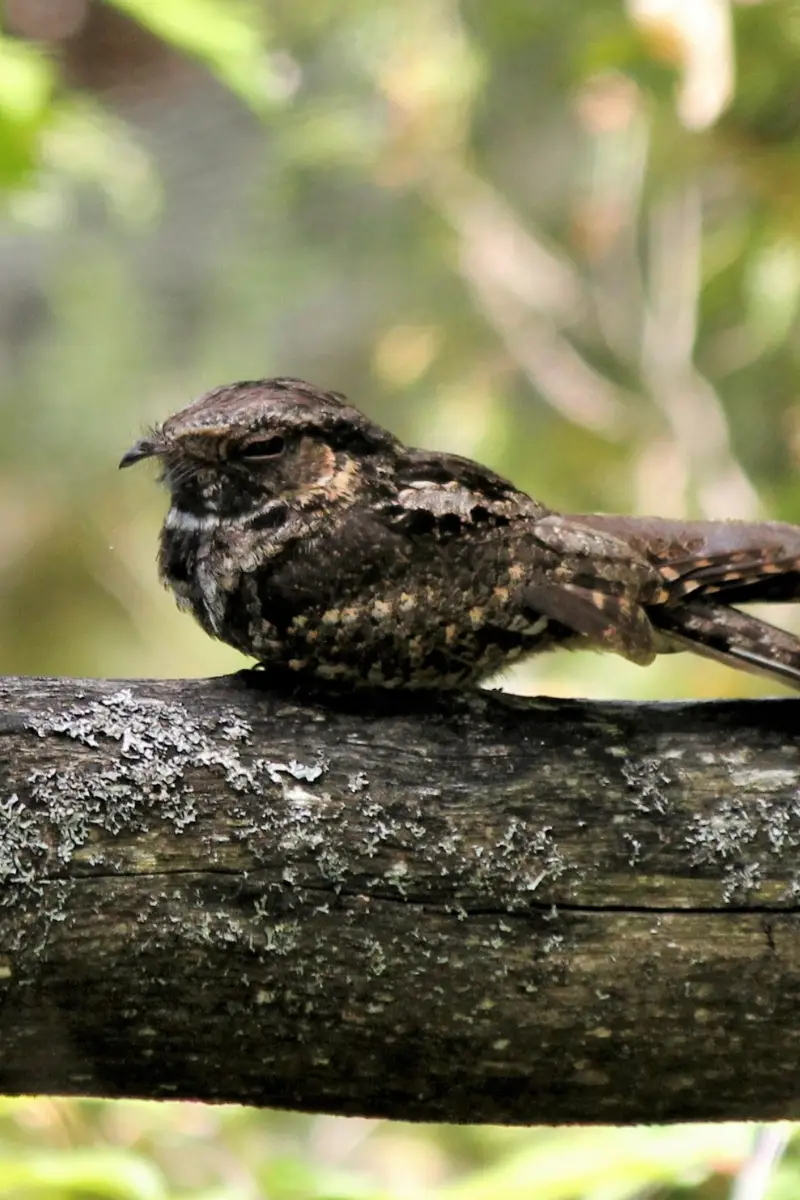
The Eastern Whip-poor-wills were once considered one species with the Mexican Whip-poor-wills. Due to the differences in vocalizations, egg coloring, and genetic analysis, these birds were separated into two distinct species. Compared to the western species, the Eastern Whip-poor-wills have a quick call, and their eggs are brighter in color.
The Eastern Whip-poor-wills have a complex mottling of gray and brown. Hence they blend in almost flawlessly with leaf litter or tree bark. They have a blackish throat neatly framed by a white bib at the bottom. Males have white dots at the tail’s end, whereas females have dull buff markings.
Eastern whip-poor-wills breed in deciduous or mixed forests spanning central and southeastern Canada and the eastern United States. After breeding, these birds move to winter in the southeastern United States, eastern Mexico, and Central America.
These birds lay eggs in point with the lunar cycle. Ten days before a full moon occurs, the eggs will hatch. The Eastern Whip-poor-wills can capture large quantities of insects in the air at night when the moon is near full, which they feed to the hatchlings. These birds can find insects by observing their shadows against the night sky. They have adapted to low light, with the back of their retina having a reflective structure. It is difficult for predators to plunder the Eastern Whip-poor-will chicks’ nests because they roam around so much as nestlings.
Common Loon
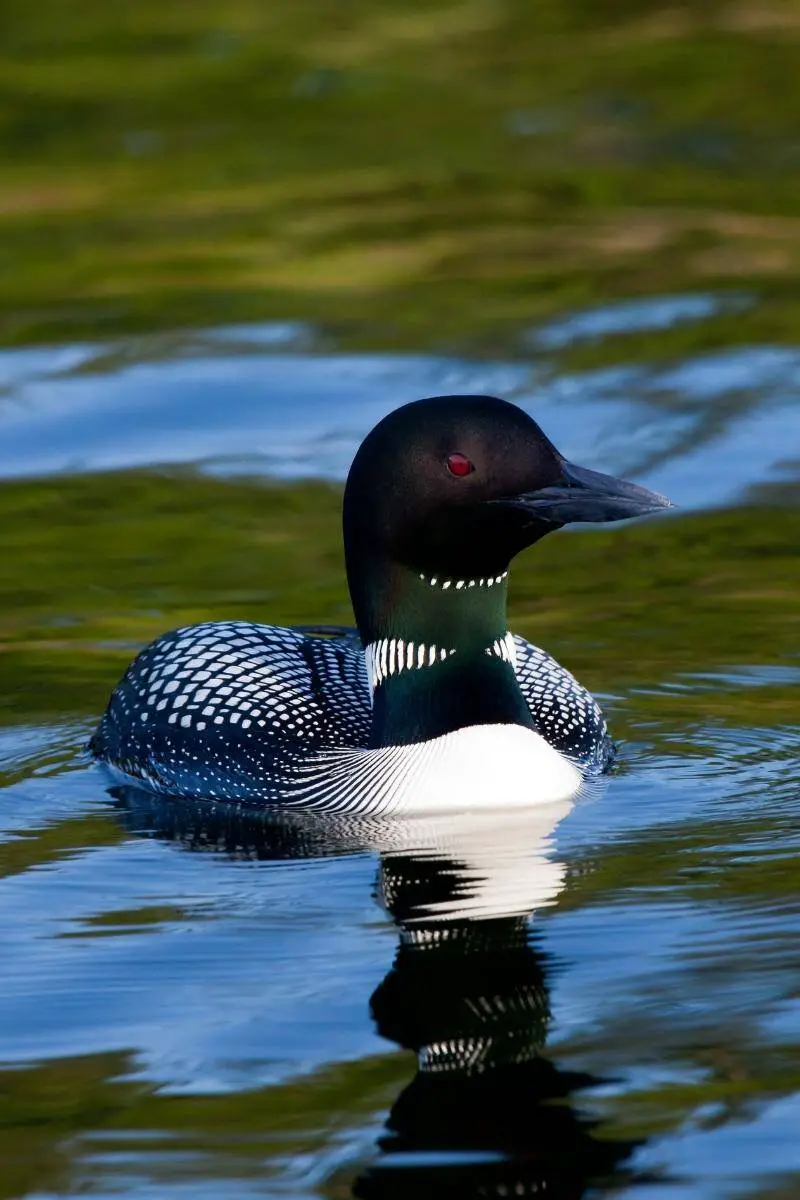
Common loons are large, diving waterbirds. These birds have round heads and thick dagger-like beaks that are grayish and may sometimes have a black tip. This species can be distinguished from the yellow-billed loon the color and angle of its bill. Common loons have long, slender bodies with short, indistinct tails. Compared to the rest of the body, the neck is comparatively thin and short.
Common loons are excellent swimmers and divers. Their solid bones set them apart from most other bird species, allowing them to swim through the water with greater agility. These birds swim deep, occasionally with only their heads above the surface. When catching fish, Common loons use their stealthy diving skills. Unlike ducks and cormorants, their feet protrude beyond the tail, giving them a wedge-like appearance. Because of this, these birds are better at navigating water but have a lot of trouble moving on land. These birds, however, only come ashore to lay their eggs.
These birds fly straight with slow wingbeats. Whenever the Common loon takes off, it has to sprint across the water’s surface. During the flight, its feet trail behind while the head hangs lower than its body. During the night, groups or pairs will often make calls. A single loon’s yodeling can evoke chorus responses from other loons in the area, making them easy to find.
The northern United States and Canada provide habitats for this species. The breeding grounds extend from western Greenland to the far north of the United States, including Alaska. During the winter, they can be found on both coasts of North America. It is common to see loons in coastal waters only during the winter when they don drab gray plumage.
The Common loon faces potential habitat loss due to the destruction of its natural territories. Human activity, such as boating, fishing, or other lakeside pastimes, affects loons to a great extent. Mercury and other heavy metals accumulate in the loons’ bodies and slowly poison them, making them vulnerable to pollution. Also destroying aquatic life and the fish they feed on is acid rain. As a result, the loons will have fewer fish to eat.
Evening Grosbeak

The Evening Grosbeak is easily identified by its huge, seed-cracking bill and distinctive gold, black, and white body. These birds have a lot of sexual dimorphisms; male birds are distinguishable by a black head, brilliant yellow lower parts and backs, black wings with big white wing patches, and black tails. They also have golden brows, and their bills turn green in the spring and summer. Females are brownish-gray with black heads. Although they have white patches on their black wings, they are less than the males’. They have golden underwings as well. Females and juveniles have similar appearances.
Even though it spends the winter in eastern temperate forests south of its breeding region, this species is a year-round resident throughout its breeding range. Many factors affect its winter range, including the amount of food in the boreal forest. They are more likely to visit platform feeders with sunflower seeds whenever they migrate, especially in areas near forested regions at higher altitudes.
These birds nest in North America’s southern boreal and northern temperate coniferous and deciduous woods, as well as western montane forests. They are more difficult to spot at this time of year because they feed and roost up in the trees, fly in smaller units, and make less noise. Evening Grosbeaks are generally found in noisy groups outside of the mating period.
While reproducing, the Evening Grosbeak is a socially monogamous species and does not exhibit territorial behaviour. Mid- to late May is when most breeding pairs assemble on their spawning grounds, and the mating season might last until the beginning of September. The nest is an open cup formed of twigs or rootlets constructed in coniferous trees over deciduous trees. There is only one clutch per year, with an average of 3 to 4 eggs. If the first clutch fails, re-nesting may happen. At 13 to 14 days old, fledglings are ready to fend for themselves.
Rock Pigeon
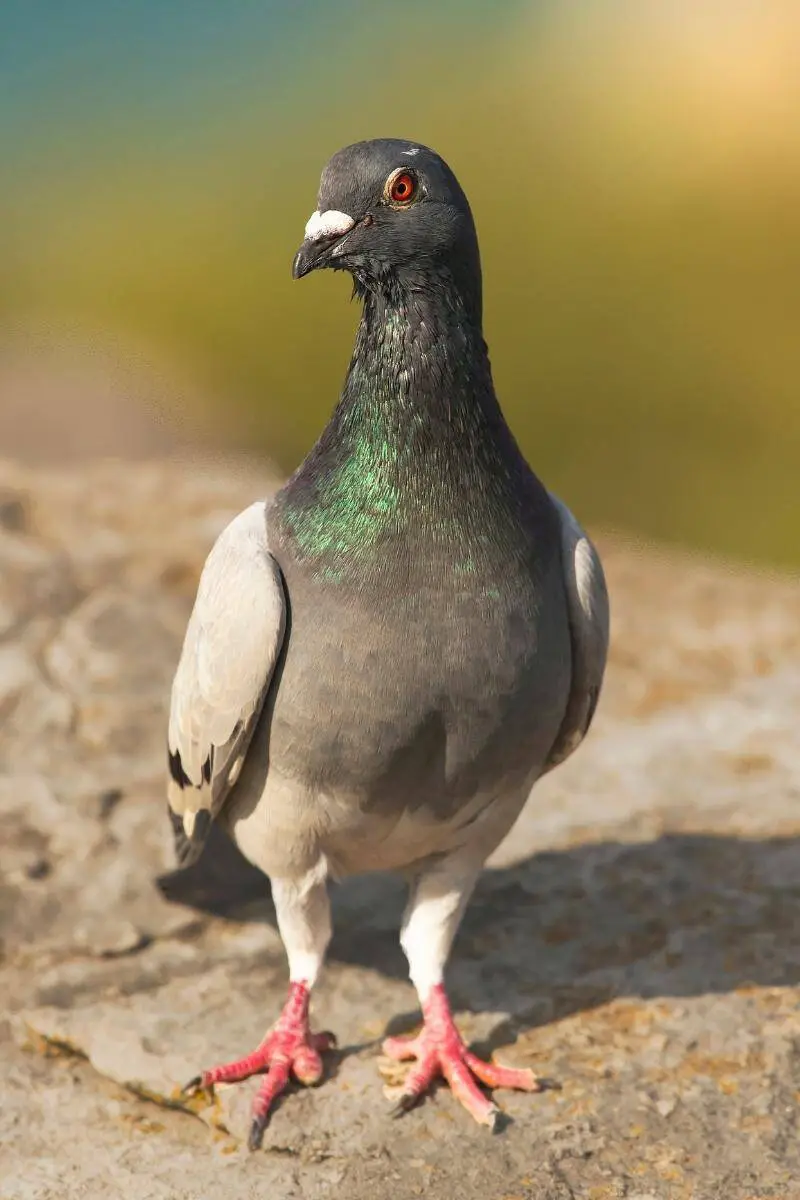
The Rock pigeons are common birds in city parks, downtown buildings, barns, and cliffs. These birds can be found in western and southern Europe, North Africa, and South Asia. In North America and Ireland, a few colonies have been brought in. During the breeding cycle, this species, which has a wide geographic range
These birds can be found in many different colors, but the wild type has a dark head and breast, a light gray body with two dark bars on the wings, and a white rump. Depending on the plumage color, the legs and feet are either red, pink, or grayish-black. It has a rounded tail and sharp wings. The sexes do not differ much.
Nests are usually constructed on either manufactured or natural ledge and kept out of sight. The nest is erected on a cliff in the wild. In cities, the nest can be found on window ledges, on roofs, in traffic lights, and under bridges. It is made of sticks, leaves, stems, roots, and detritus. This species typically has a single brood each year and lays two eggs. Both sexes are responsible for taking care of the young.
A flock is formed when roosting, bathing, and eating. These pigeons walk or run with their heads bobbing back and forth to keep their balance. The Rock pigeon flies in a straight line and at a constant speed. These birds are most commonly spotted at daybreak, especially in metropolitan parks or perched on skyscrapers. They seek shelter at night or amid the day’s oppressive heat.
Gadwall
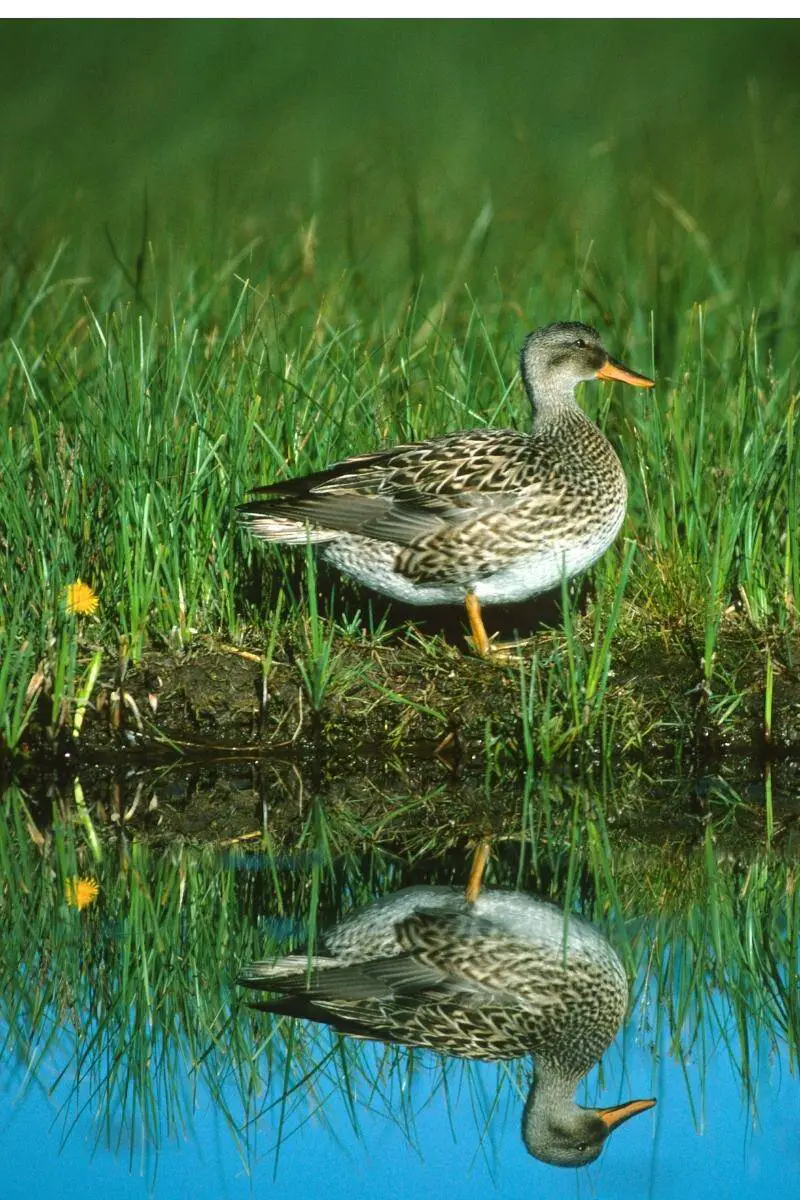
These birds reproduce near seasonal and semi-permanent wetlands. Unlike most other ducks, Gadwalls begin breeding earlier. They are likely to be seen in twos throughout the winter as they begin selecting partners for the mating season as early as fall. Fresh and brackish marshes along the coast and inland ponds and reservoirs are among the Gadwall’s winter habitats. They can be found in wetlands with emergent plants like the Great Plains prairie potholes in the summer.
Unlike other North American dabbling duck species, Gadwalls have higher reproductive success. While they are generally quiet, these birds are loud during their courtship exhibitions. The males produce grunts and whistles while the females give a higher-pitched version of the female mallard’s quack. Gadwall, which feeds with other dabbling ducks, steals food from diving ducks or coots.
The Gadwall is an extremely grey-colored dabbling duck. Fine barring and tiny spots give the grey color its distinctive appearance when seen near. Gadwalls have a dark orange-edged bill and white belly and speculum, differentiating them from other species. The female’s plumage is light brown. Both sexes undergo two molts each year after the juvenile molt. When flying, a white wing patch can be seen. They are smaller and have a more apparent black tail than the mallard.
Belted Kingfisher
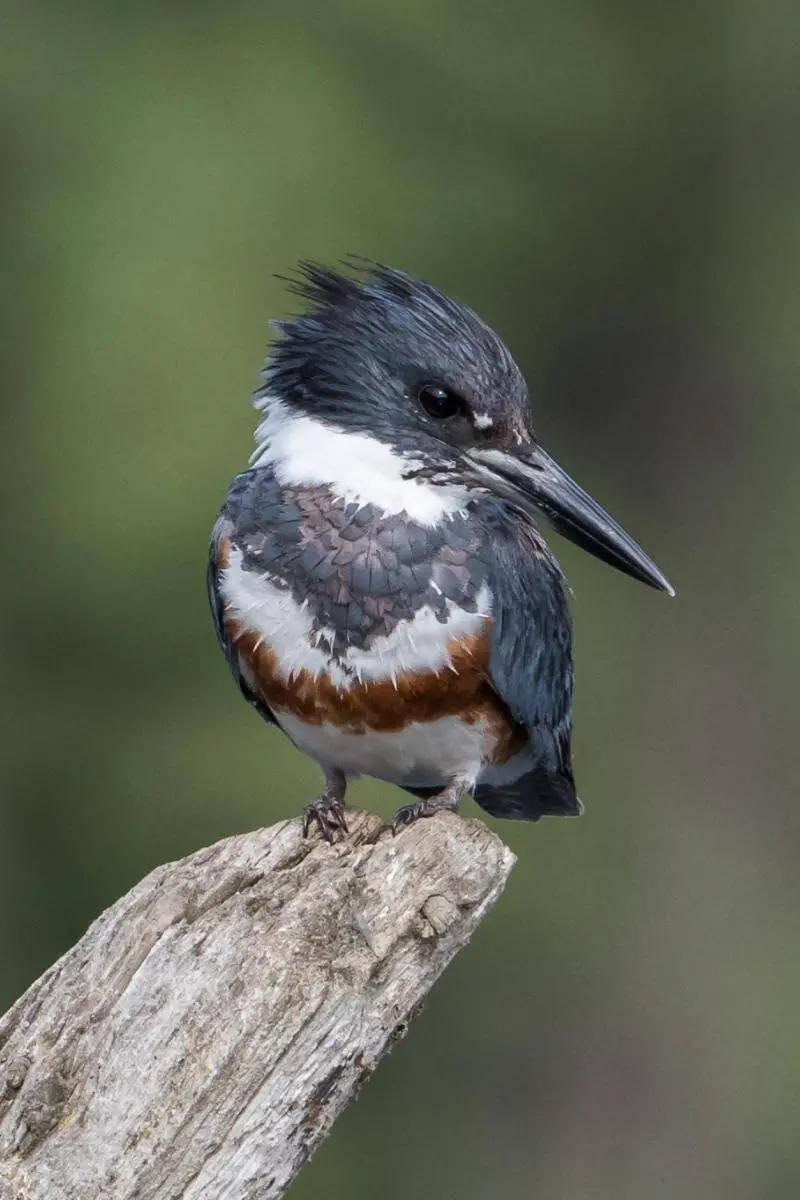
North America’s northernmost regions are the only places where the Belted Kingfisher can not be found. They move as far south as they need to locate open water in the winter because of their hunting method. It is a year-round resident of the United States with limited migration. If water is abundant, these birds can withstand extremely low temperatures. Migrating birds from Canada and Alaska spend the winter months in the southern United States, the Caribbean, Central America, and northern South America.
Belted Kingfishers can be found all over North America’s lakes and shorelines. They can also be found perched on riverfront branches and phone lines or spotted flying overhead.
For nesting, the Belted kingfishers excavate burrows in an earthen bank near a body of water. Both sexes dig, but the male does most of the work and uses their bills and little feet to remove the dirt. These burrows are never lined. The bird reuses the burrows during subsequent seasons even though the site might not be stable.
Belted kingfishers consume fish, crayfish, frogs, turtles, insects, young birds, toads, snakes, mice, and even fruits. To catch prey in ponds or lakes, Belted kingfishers dive headfirst. A caught fish is first pounded against a tree, thrown into the air, and swallowed headfirst.
Snow Goose
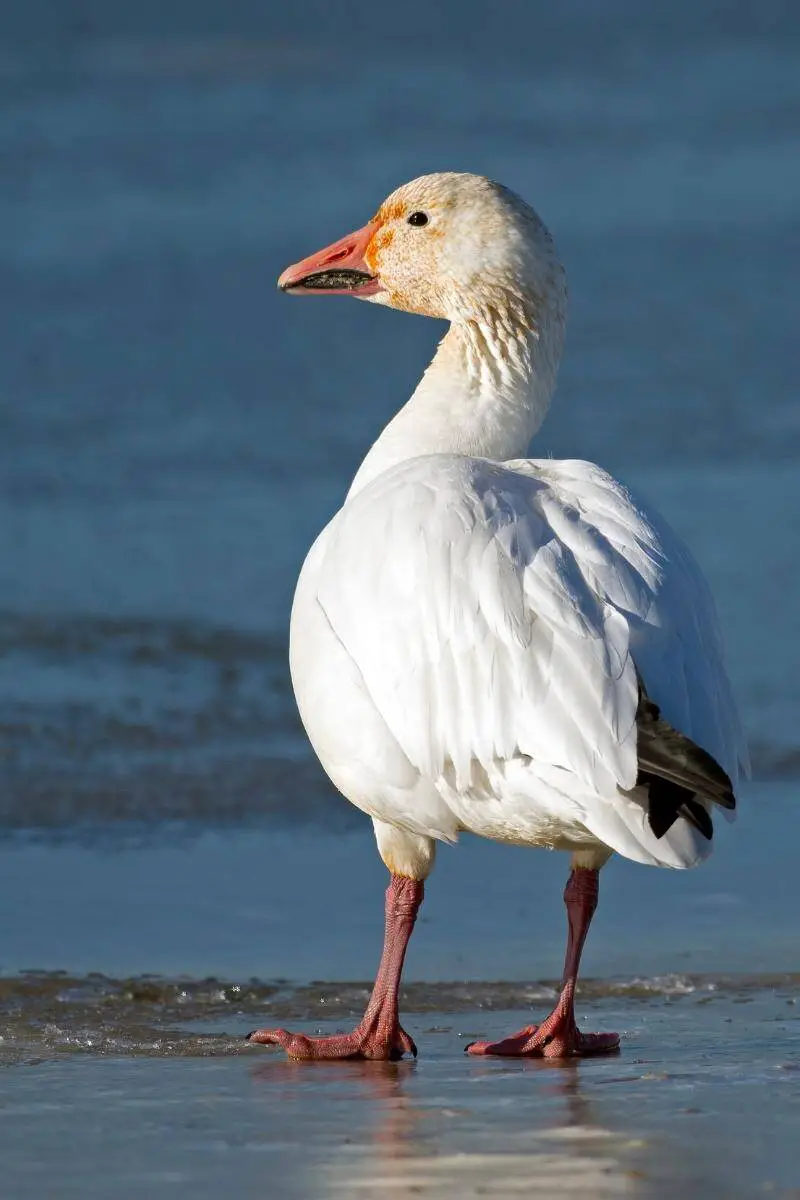
The Snow Goose has a thick pink, jagged beak, long neck, and red feet and legs. A dark stripe, known as a “grinning patch,” runs along the beak. Snow Geese have a dark morph of dark brown with a white undertail and face. The snow goose’s body is white with black wingtips during its “snow” phase. The young can be distinguished in flocks in the late fall and early winter because of their relatively diminutive size.
Family groups feed together on their wintering habitats by digging for roots and tubers from muddy fields and marshes using robust, jagged beaks. They eat rushes, cattails, grass, clover, and grains, which they forage in farm fields. The Snow Geese prefer to be accompanied by at least a dozen other geese when moving around. Their wingbeats are constant and steady as they soar through the air.
They migrate to the Arctic tundra to mate, where tens of thousands of breeding groups can be found. They prefer coastal lagoons, marshes, tidal flats, and estuaries in general, but they have been found to use prairies and agricultural fields as well. White geese hybridize with blue geese, preferring to mate with a partner who shares their parents’ coloration. Nests are shallow pits in the ground bordered with dry foliage. Three to five eggs are laid by females. Incubation lasts for about 23 to 25 days. After 45 days, the hatchlings fledge. These birds mature after two years.
Pied-billed Grebe
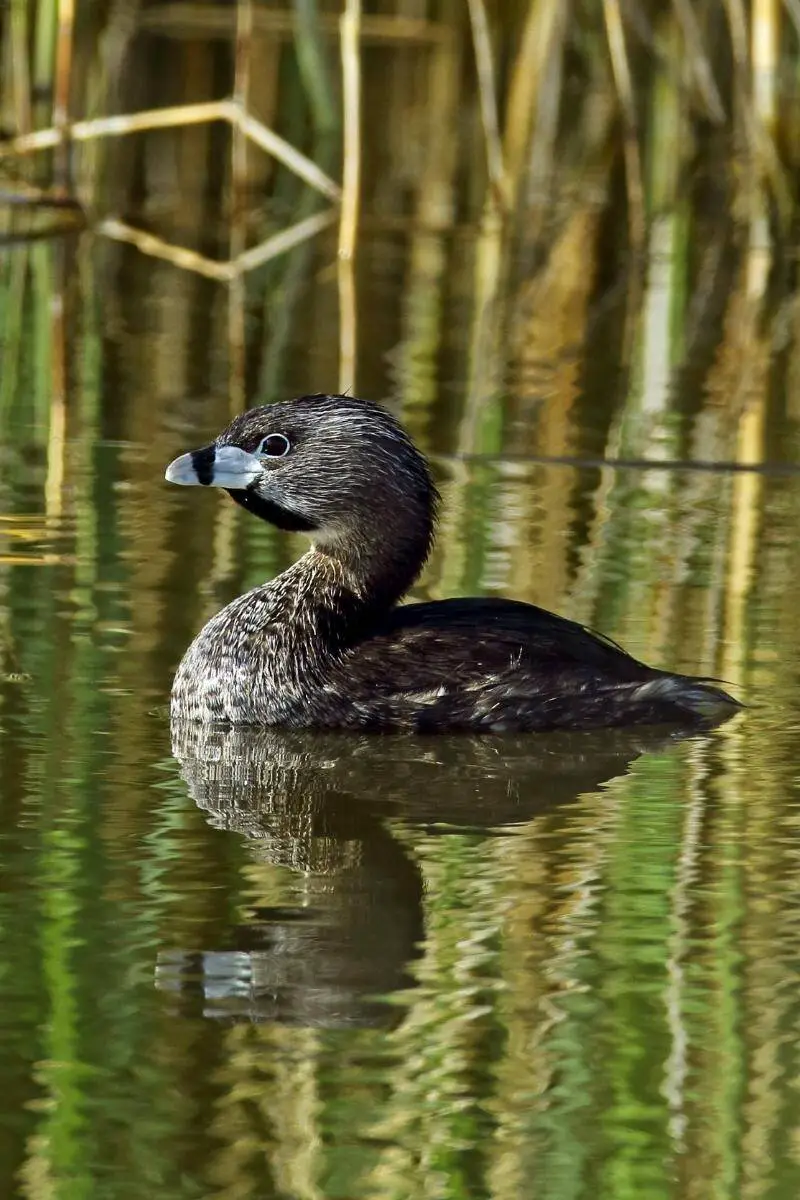
Pied-billed Grebes are small, chunky waterfowl with thin necks and compact bodies. These fowls feature huge, blocky heads and short, hefty beaks, and their feathers are predominantly brown with a darker back and crown. Other than the females being considerably smaller, both sexes are similar. In the marshes where they reside, their brown color provides excellent disguise.
The throat turns black in the summertime. Striped juveniles seem more like winter adults with black and white stripes. During the mating season, the bird’s white bill is accented with a vertical black stripe, earning the nickname “pied-billed.”
They are most usually spotted in the United States, Central and South America, and the Caribbean all year long. They are most common in central, northern, and northeastern Canada during the breeding period. If they live in a region where the ice forms during the winter months, they migrate away. In September and October, migratory birds meet year-round birds. These birds travel during the night.
Both sexes construct a drifting nest of plant debris tied to or among live or dead vegetation in water at least 1 ft deep. Within a day of hatching, young can vacate the nest, although they tend to stay on the nest platform. The young are fed by both parents and maybe carried on their backs, even submerged. The young can swim on their own within a few days of hatching.
One of the most reclusive North American grebes is the pied-billed grebe. Despite their tolerance for crowding, they favor a nesting area of at least half an acre to ten acres in size. They are highly reticent and solitary. In the event of an attack, the pied-billed grebe dives into the water and hides in the foliage. It prefers to avoid danger by diving and migrating at night; thus, it is rarely observed soaring.
Tundra Swan
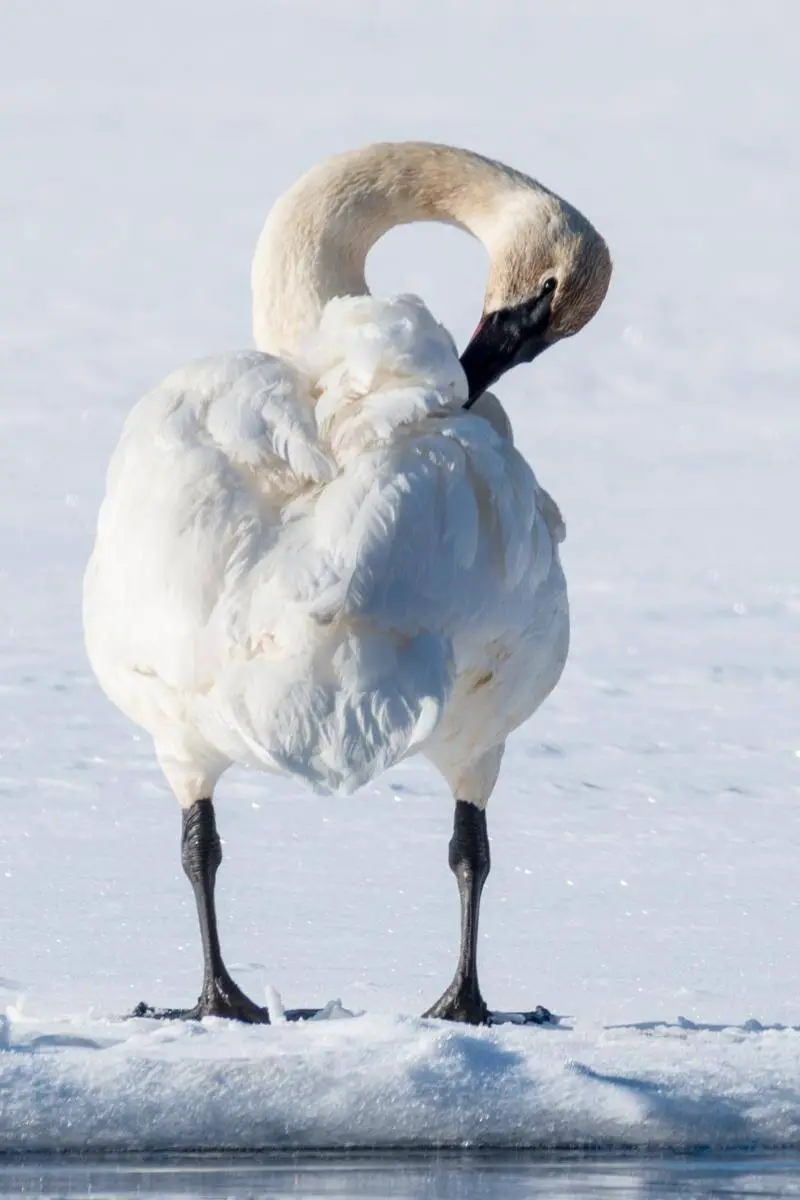
Once known as the whistling swan, Tundra Swans’ feathers are white. The primarily black bill has a yellow patch at the base, and the limbs and feet are also dark. The wings, heads, and necks of juvenile birds are stained with gray.
Tundra swans can only fly after completing a long series of running steps, whether they take off from water or land. Individuals can fly at speeds of up to 50 mph. Tundra Swans fly with their necks extended when they are in the air.
They forage on the water like dabbling ducks by plunging their heads underwater. Their diet consists of aquatic plants, roots, and tubers that they gather with their beaks dipped in water. They may also consume mollusks.
Northern Alaska and Canada are breeding grounds for the tundra swan. These birds make round-trips twice a year between their mating and hibernating grounds. Migration takes three to four months to complete in the late winter or early spring months. Tundra Swans can stay on stopover grounds as late as necessary to reap the benefits of abundant food. During the spring and fall, tundra swans can be seen flying across Pennsylvania, and some of them spend the winter in the southern section of the state. Swans seen nesting in Pennsylvania are mute swans.
Tundra swans couple in late spring, often after returning to their breeding sites. As with other swan species, they couple monogamously till one passes. An individual bird may not mate again for several years or possibly its whole life if the partner dies. In a high location near open water, the pair builds a vast mound-shaped nest from plant matter and defends a broad region surrounding it. Two to seven eggs are laid and incubated by the pen (female) while she keeps an eye on the nest for threat. The male cob is constantly on the lookout for predators traveling near the nest. Their partner is alerted when they hear or see an imminent danger signal. The cob will utilize his wings to run quicker and look bigger to frighten off predators
Green-winged teal
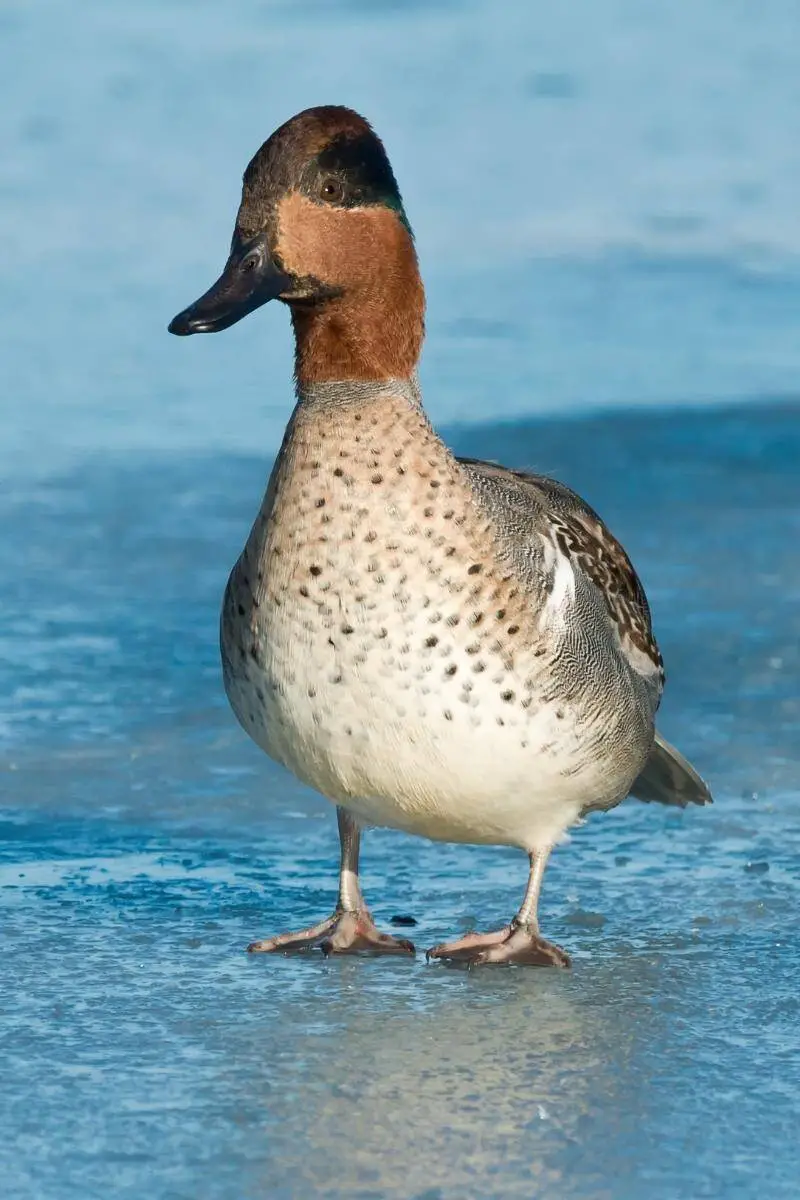
The Green-winged teal is North America’s smallest duck. Males in breeding plumage are chestnut-red with large green patches that stretch from the eyes and link at the back of the neck. On the pinkish-brown chest of the male, tiny black spots can be seen. Like other female puddle ducks, female green-winged teal is a blend of browns and tans. Both the females and males have wing patches with metallic green, gray legs, and tiny black beaks. When flying, a dazzling white belly can be seen. The male’s chest is separated from the gray flanks by a white stripe; the undertail is black.
Green-winged teals have three subspecies that occur in the northern hemisphere during summer and winter, extending from southern India to Burma to northern South America and from Burma to northern South America. This migrating dabbling duck spends its time far south of its breeding ground in the winter. When it’s not breeding, it’s sociable and will gather in big groups.
While they favor small, subsurface, permanent ponds close to boreal forests with a high abundance of emergent vegetation, they can also nest in Prairie Pothole country or densely vegetated areas. This bird’s nest is made of grasses, leaves, weeds, and feathers and down, used as bedding. The average number of eggs laid by a female green-winged teal is 8-9. Because only the females incubate, when they are away from the nest, they cover the eggs with down to keep them warm. The males depart after the eggs hatch. Females are pretty violent when it comes to protecting their young. Predators like skunks and crows can be thwarted by a group of female green-winged teals working together.
Double-crested Cormorant
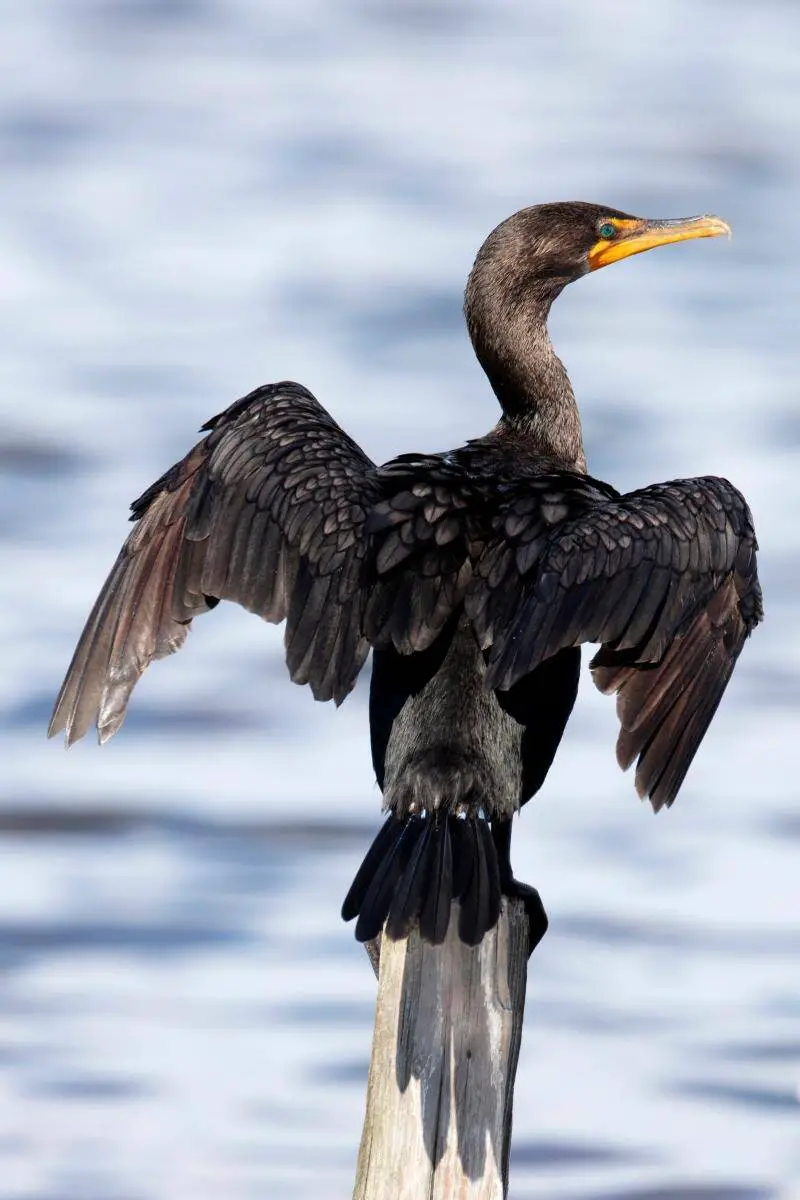
The Double-crested cormorants have five subspecies, which vary significantly in size, color, and crest shape. It is common to see these birds perched on piers and rocks with their wings outstretched in a spread eagle pose. The double-crested cormorant is distinguished by its yellow-orange, unfeathered throat pouch. The adult bird head’s left and right sides have crests in breeding plumage. Juveniles are noticeable by a dull brown to the whitish coloration on the neck, chin, and throat. Flying low over the water, they have an unusually long tail and long, crooked neck. Unlike squawking flocks of geese, a traveling flock can form a line or a wedge shape.
In the winter, it can be found almost anywhere along the east and west coasts where there isn’t ice, up to and including southern Alaska and southern New England (on the east coast). It comes to Europe as an infrequent visitor from the coldest regions of its breeding range, such as eastern Canada.
Because there are so few trees in the ocean, marine birds usually lay their eggs on the ground. On the other hand, Inland populations make use of trees to build their nests. Both marine and inland populations form colonies ranging from a few birds to thousands of birds. Herons, in particular, will easily co-nest with them. The female can lay up to seven blueish or green eggs after copulation, but three or four are more common. Eggs hatch within a month of being incubated by both parents. It may take 35 days or longer for the young to fledge.
During the daytime, Double-crested cormorants hunt for fish by diving. These birds also eat aquatic invertebrates like insects, crustaceans, and amphibians. They use their long, hooked bills to snatch prey from the depths of the water. After surfacing from a dive, Cormorants search for a raised perch where they can spread their wings and dry their feathers.

